

Why I Love Australia
Michela Solo Female Travel Australia Solo Travel 8
Reasons For Falling in Love with Australia
In +15 years of travel blogging, I have often been asked: Why do you visit Australia? M y answer has always been short and simple: Because I love Australia . Australia is an excellent country for women travelling alone over 50 . On my solo travels in Australia , I discovered beautiful places that had sometimes been hard to leave.
Here are the places I love in Australia and why I fell in love with the country.
What I love about Australia
With +15 years of solo travel in Australia, I have been to hundreds of places in Australia. Although I don’t have a favourite one, these are the best places to travel alone in Australia, and the different ways of exploring the country made me fall in love with Australia.
I’m very fond of Sydney cause it’s the first place I visited in Australia, and it made me instantly feel good. I love Sydney. I spent my 40th Birthday there in 2004 on my first backpacking trip to Australia. There are plenty of walks and fun outdoor activities in and around Sydney . Also, Sydney was the starting or ending place of many discovering trips to the East Coast of Australia , by bus, train and road trips around Australia.
Melbourne has got something special. I loved it on my first trip. What I liked most is how relaxed people are in the city. You can tell that people love their town and are happy with it. Of course, there is always something that needs to improve. But I would dare say that this Australian city is no. 1 in Australia for making travellers feel at home.
And I was not making the city CBD too expensive to get around and stay in. The Melbourne free trams in the CBD highlight the many fun things to do alone in Melbourne .
Adelaide is a city with an evolving story. I have been there four times on my travels in Australia. While my feelings were initially neutral, my excitement grew over the years as I saw Adelaide showing its distinctly twofold character: a quiet place to live in but simultaneously a dynamic personality. Indeed there are lots of events and exciting things to do in Adelaide . I love biking, and Adelaide, with its parklands, is an excellent place for cycling to the beach.
I have been to Perth solo seven times on backpacking trips, aboard the Indian Pacific from Adelaide to Perth , and spent a long time house-sitting in North Perth and on the northern beaches. From there, I went on road trips exploring the Perth region on day trips . Perth is a delight with its relaxed lifestyle and fun outdoor things to do solo in Perth .
Margaret River
The Margaret River Region was a massive surprise to me. In 2008, when I first travelled to Western Australia, my idea of the South West was pretty ignorant. I thought there were only forests and surf beaches. When I started my solo road trip to South Western Australia , I was in awe of this region’s beauty, richness and diversity. I could think of settling there for a while and making it home.
I love Darwin . This is a place I felt at home straight away after my arrival. I love the relaxed atmosphere and the wide-open view over the harbour. I love Darwin’s isolated beaches, markets, and phenomenal sunsets. On my first visit, I remember walking into a Church on a Sunday morning and sitting with locals. It made me feel at home and part of the community. Here you can read a list of fun things to do in Darwin alone .
Great Ocean Road
South western australia, north tropical queensland.
North Tropical Queensland is a region of Australia. I like it very much for its distinctly Australian character: The rainforest and the wealth of tropical vegetation with its incredible native tastes and local produce. I travelled around by bus on my first trip. On the second trip, in 2014, I hired a car in Cairns and explored the entire area.
I spent time camping solo in Cape Tribulation and enjoyed many fun and free things to do in Cairns. I also went on a day trip to the Atherton Tablelands. With good dry weather, September is among the best months to discover North Tropical Queensland .
North Western Australia
The North West Coast of Australia is immense; you must break it down into smaller regions. Besides South West Australia, another region I love is the northwestern coast from Coral Bay up to Broome.
I first discovered Margaret River in 2013. In 2017, I went on a road trip down-south to explore beautiful South Western Australia with Denmark and Albany. Here you can learn about my road trip down south WA . And my favourite things to do in Albany .
I first visited Broome in 2008 in February with hot and humid weather, so on my return visit in 2015. I went on a guided tour from Broome to the Kimberleys.
From there visited the Eastern Kimberley on a scenic flight over the Ord River to the Bungle Bungles. This area is imposing because of its geological formations and the second-largest water system, making it an exciting and unique ecosystem. While it is not recommended for solo travellers, I loved exploring the Kimberley region and enjoyed the walks and many things to do in Kununurra .
More reasons why I love Australia
- I love Australia because of the friendly Aussie .
- I love meeting the locals, listening to their stories, and learning about their culture.
- I also profoundly love Australia because of the freedom, lightness and safety that reign everywhere .
- I love the inspiration I get from the isolation in the Australian Outback .
- I love the isolation, the solitude, the emptiness and the magnificent sunsets of the Australian outback .
- I love Australia’s Outback colours: its deep blue sky, rugged red earth, and lush green to golden brown vegetation.
- I love to wake up in the outback by screeching corellas and the crisp air caressing my hair.
- I love Australian native animals . I love spotting kangaroos.
My travels around Australia are full of positive emotions and inspirational life experiences that fuelled my energy and enthusiasm to venture into solo travel and travel blogging.
Go to the Guide to Solo Travel in Australia
Go back to Rocky Travel
We respect your privacy, deliver only valuable content. No spam ever.
Michela Fantinel
→ Michela Fantinel
Related Posts
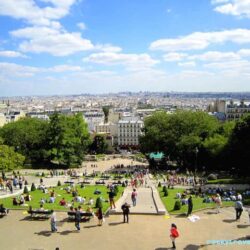
Solo Female Travel
8 Safe Cities To Travel Solo As a Woman

Europe , Solo Female Travel
The Best Experiences For Solo Travel To Europe

5 Reasons To Visit France As A Solo Traveller 50+
Brooke, Why Go Australia October 17, 2011 @ 8:06 am
Aw such a good post 🙂 I love that you love Australia so much!!! Travel here does feel safe… except for all those poisonous things haha ;
Rocky Travel - Solo Travel Australia October 19, 2011 @ 8:21 am
Thanks, Brooke. I had no close encounters with all those poisonous things. I only know them from warning signs. Thank you for setting up this Australia Blog Roundtable.
Caz Makepeace October 18, 2011 @ 8:07 am
It is always so great to hear how much those who weren’t born here love my beautiful country. Great to be participating in the roundtable with you.
Rocky Travel - Solo Travel Australia October 19, 2011 @ 8:22 am
I like to think of myself like as “Aussie at heart”…. who knows maybe in a previous life I was a real Aussie! Lovely to have you in this roundtable Caz!
NLM October 19, 2011 @ 8:10 am
As much as anything, it sounds as if Australia offers all kinds of freedoms…I’m ready for more of those! Thanks for the post. Nancy
Rocky Travel - Solo Travel Australia October 19, 2011 @ 8:23 am
yes, Nancy, Australia is indeed a special place for solo travellers. I hope you can visit it soon!
Lisa Wood October 23, 2011 @ 8:11 am
we live in Australia and we love it! We travel around in our Motorhome and love exploring all there is to see! Love your story Why I love Australia article. Cheers Lisa
AussieCampervan November 30, -0001 @ 12:00 am
Ya, same thing with me too. I also felt in love with Australia during my first visit. There are various nice places which are unforgettable, local people of Australia are so much friendly. Nice country. I would love to go there again and again.
Leave a Reply Cancel reply
Your email address will not be published. Required fields are marked *
Privacy Overview
Notes From Abroad: I Went All The Way To Australia And All I Got Was The Best Customer Service Of My Life
I had to travel all the way across the world to Australia to experience the most memorable customer service experience of my life. It was in Sydney, specifically, at the Old Clare Hotel , a 62-room boutique in the heart of the city’s vibrant Chippendale district . Like many of the hyper-cool neighborhoods in the world’s great cities, Chippendale was once a slum that has transformed over time into a mecca of art, design, and food. I was there during Vivid Sydney , a three-week long arts and culture festival held each May/June that bills itself as “the world’s largest festival of light, music and ideas.”
Now, here’s the scenario that produced the aforementioned bit of memorable customer service: The night before I was to fly to Australia, the Golden State Warriors beat the Oklahoma City Thunder in game six of the NBA’s Western Conference Finals, forcing a game seven. Based on everything I’d seen, I knew that game seven would be one that I just couldn’t miss, no matter where in the world I was. So without really thinking too much about it, I tossed a line out on Twitter, hoping that maybe someone who follows me might be able to assist in pointing me in the direction of an American-basketball-friendly bar.
“Now I’ve got to find a bar in Sydney to watch game 7,” I tweeted . “Anyone know of one? I’m guessing the Warriors have some fans there because of Bogut.”
In the past, I’ve found this to be a quite effective recommendation-gathering tool when traveling, but in this case I really didn’t get much help from anyone. I suppose my base of followers doesn’t consist of many NBA fans who’ve traveled to Sydney during the season. “Oh well,” I thought, “I’ll figure it out.” Surely, there would be a way to stream the game online or something. I’d worry about that later, as the next day I was to board a Virgin Australia jet for my 14-hour flight Down Under.
When I checked in to the Old Clare and made my way to my room, I discovered that someone on the staff had apparently checked my social media accounts prior to my arrival and noticed the tweet about a place to watch game seven. My tweet was printed out and framed and accompanying it were some hotel coasters with recommendations listed on them. They also tossed in some facial products from Triumph & Disaster (which I loved) for extra measure. I can only presume that digging though my Twitter archive they must have also noticed that I’m a man who loves a good exfoliation every now and then.
https://twitter.com/thecajunboy/status/737419836964249601
I later learned that this sort of thing is something the hotel does regularly. The Old Clare social media staff will often check the social media accounts of people with upcoming reservations to see if they can spot any way to proactively enhance the guest’s stay prior to arrival. It’s so simple, but so uncommon, and rather genius at the same time. There’s also something about it that’s mildly creepy, but hey, this is the world we live in. In 2017, anything we post online is there for the whole world to see, so why not have merchants that seek to make our lives easier and more pleasurable use what we post to do just that?
With that anecdote unpacked, here are a few more of the things I did/saw/heard/felt when I spent a week in Australia in June of 2016.
— Speaking of the Old Clare Hotel in Sydney, the robe in my room was the most luxurious-feeling hotel robe I’ve ever experienced. I loved mine so much that I bought it and brought it home (It cost me just over a hundred bucks to do so). I’m actually wearing it right now as I type this! And the scrambled eggs served at breakfast — which Australians call “brekky” — at Kensington Street Social, one of the hotel’s two great restaurants, were arguably the best I’ve ever had.
— Visiting Sydney during Vivid Sydney turned out to be an extraordinarily fortunate occurrence for me. I got to see two of my favorite musical acts — Bon Iver and Polica — perform at the Sydney Opera House, one of the world’s iconic performance spaces, and I found myself utterly mesmerized by the displays of lights all over the city each night. Think of it this way: one of the world’s most beautiful cities was literally lit every night. I can only imagine how much better it would have been had I experienced it on acid, but I refrained. The timelapse video below demonstrates how captivating this was much better than I could possibly convey in words.
— When I tuned in to the local news that first night at the Old Clare, news from America dominated the top of the program. The top news of the night was a story about Harambe (Australians were obsessed with the killing of Harambe), with the second story of the night being about Trump and whatever ridiculous things he said on the campaign trail that day. (Interestingly, Australia had its own presidential election that would take place just a few weeks later, in July , but it was dwarfed by interest in the U.S. presidential race.) The third story on the news that night was about a woman who had died in a crocodile attack after she and a friend were at the beach and ventured out into waist-deep water for a night swim. (Coincidentally, I did everything I could to avoid going into the ocean during my time in Australia.) Oh, and another story on the news when I arrived in Australia — a kangaroo attacked a woman riding a bike, causing her breast implants to rupture. I am not making any of this up, I swear.
— Around the corner from the Old Clare is a street called “Spice Alley” that features literally every kind of Asian cuisine imaginable. Thai, Chinese, Vietnamese, Korean, Japanese…you name it. It was heavenly.
— The morning I landed in Sydney everyone was consumed by how “cold” it was . As I was being driven by a livery driver to my hotel from the airport, I heard a morning radio host say that it was the coldest day Sydney would have in five years. Curious because it didn’t really feel all that cold to me, I checked the weather app on my phone to get the temperature — it was 46 degrees Fahrenheit. In other words, a mild fall day for most Americans.. By the afternoon the temperature would rise to the mid-60s, but the locals were running around in heavy coats and scarves and mittens and whatnot.
— Public wifi was oddly difficult to find in Sydney. Most coffee shops do not offer it, unlike in the U.S. Because of that, presumably, this is a place where internet cafes continue to exist and thrive. It was very surprising for one of the world’s most modern cities.
— It’s not usual when traveling abroad to see American 7-Elevens all over the place, but Sydney is chock full of them.
— Bars in Sydney close early — at 1:30am. If you want to drink past that time you have to go to one of the local casinos, where booze is served deep into the night. I wonder how much the casino companies paid off local politicians to make this a thing?
— One of the cab drivers I had in Sydney was an Indian man who had a gazillion questions about the gun laws in America. I think he was hoping that I could help him make sense of them, which I could not. He mentioned that he had family members living in the U.S., including a daughter who was attending a university to get her Ph.D in physics. He told me that he worried about them and has been asking all of his family to leave the U.S. and move to Australia. “America is just too dangerous,” he said. And to think that this was before two Indian engineers were the victims of a shooting spree in Kansas at the hands of a man who thought he was shooting Iranians .
— After a few days in Sydney, I took a short flight up Australia’s Eastern coast to the town of Byron Bay. It is here that I have determined that I would like to die. Specifically, at the beachfront resort I stayed while in Byron, the Elements of Byron. Embedded below is a video tour of the property. Perhaps after viewing it you’ll understand why I favor it as a place to die. For the record, I would not mind living here, either. To both live and die in Byron Bay, Australia would not be all that bad. Maybe this could be the town’s new slogan: “Byron Bay: a great place to live, but a better place to die.”
— The property that the Elements of Byron sits on, and is surrounded by, is one of the most breathtaking stretches of land I’ve ever set foot on. The resort features just over 100 villas that are spread out along miles of coastline which feel somehow virtually untouched by man. Even better, because it was “winter” in Australia and few people were staying at the resort while I was there, I had miles and miles of stunning beach to myself each day I was there. I literally never encountered another person on the beach at any point during my time there, and I went for hour-long walks on the beach each morning and afternoon. It almost didn’t seem real.
I was so moved by the scenery that I even tried doing yoga and meditating for the first times in my life. I mean, when in Rome and whatnot, right?
On the last day I was there — after having not seen another human being on the beach for days — I stripped off all my clothes and walked for miles naked that morning. I discovered that walking naked on the beach as a cool breeze blows while the sun rises over the horizon is intoxicatingly liberating. Any walks on the beach for the remainder of my life will pale in comparison to this one. So yeah, I love Byron Bay, Australia and I recommend staying at the Elements of Byron if you go there. (Also, go during the winter . Trust me on this.) If the beach isn’t your thing, the pool situation at the resort is way above average.
And this is what sunrise looks like from the beach at the Elements of Byron. I was naked when I took this photo, btw.
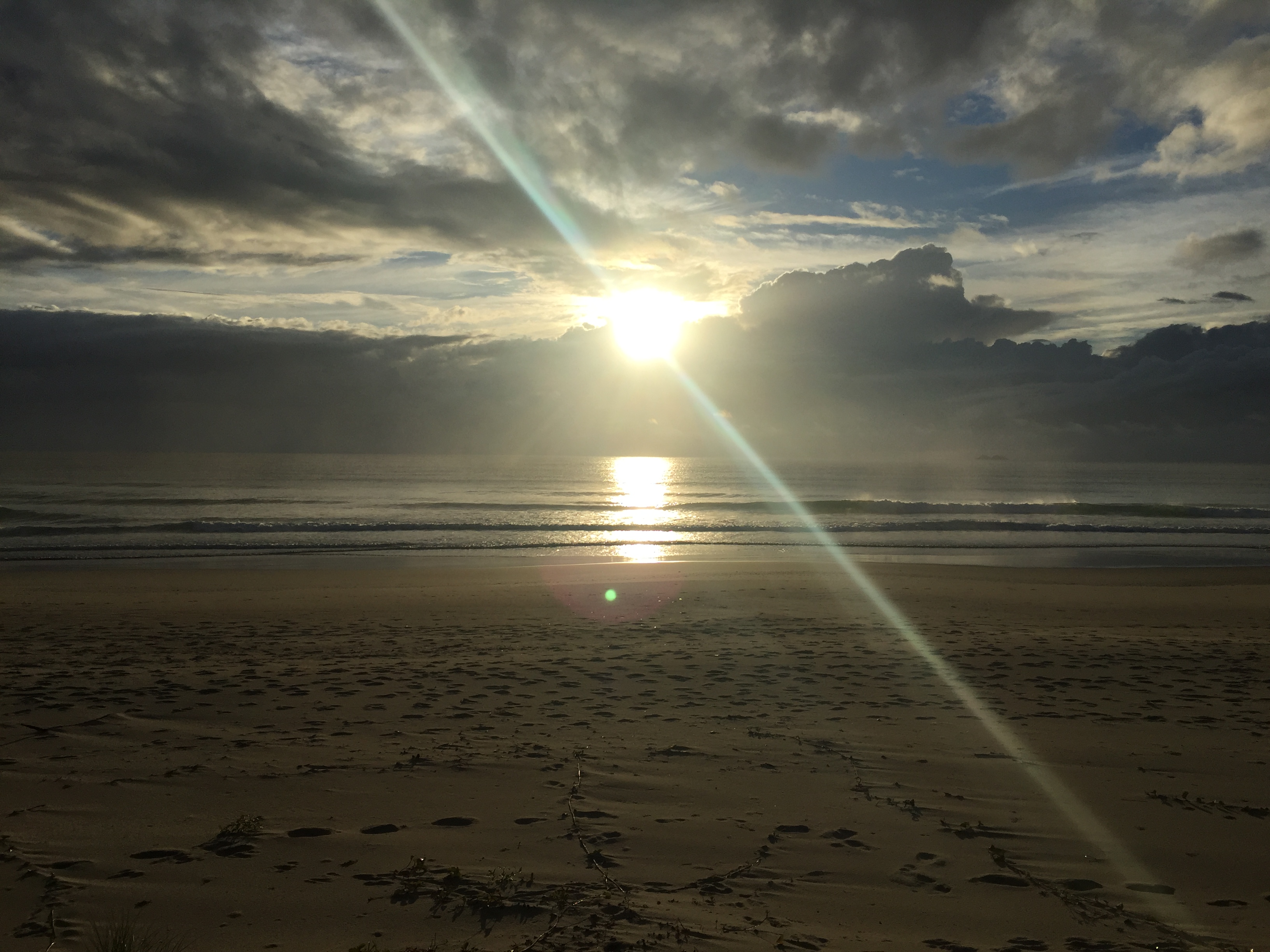
— Byron Bay is quite small, with a total population of around 9,000. To drive there from Sydney would take about 10 hours because of the rugged terrain one would encounter along the route, while a flight only took about an hour and a half, if that. The area was first popularized due to surfers flocking to the area once word got out about its pristine beaches and crystal clear waters. The area’s most famous local landmark is a lighthouse that was built in 1901 and it situated on the most eastern part of Australia’s mainland.
— And here’s the view of the ocean down below from atop the hill where the lighthouse sits. I almost plunged to my death to get this shot, so I hope you all appreciate it.
— After spending a few days in Byron, I returned to Sydney where I experienced the only real disappointment of my trip. I was to spend my last two days of my trip in Bondi, the beach-y part of Sydney. For weeks leading up to my trip, everyone I spoke to who’s been to Sydney raved about Bondi and told me how much I would love it. But a bad weather system passed through upon my arrival and stuck around for the remainder of my trip. And when I say “bad weather system,” I’m talking dangerous winds and torrential rains, weather so extreme that the local surfers — who usually flock to the sea during storms for the big waves — were implored not to go out. Things were so bad that multiple motorists drowned in their cars after being stranded by floodwaters. One man was apparently sitting on rocks near the ocean and was swept into the sea by a huge wave.
Needless to say, I didn’t get in any good beach time at Bondi and spent most of my time there in my hotel room. On the bright side, the hotel I stayed at — the QT Bondi — was utterly fabulous with a staff that was extraordinarily helpful and accommodating. I’d put staffs of all three places I stayed in Australia — the Old Clare, Elements of Byron, and the QT Bondi — up against any hotel staffs in the world. I remain to this day completely blown away.
— On my last full day in Sydney I had had a private tour of the city with a man named Richard Graham, who runs a local tourism company called My Detour . Richard typically conducts his tours in a 1964 Holden, a classic Australian car, but because of the shitty weather and risk of flooding we had to do this one in an elevated mini-van. Richard was an encyclopedia of local knowledge and just a really fun dude to spend four hours in a vehicle with — something I can’t say for most human beings. My only regret is that I didn’t do the tour with him at the beginning of my trip. Having the knowledge I received from him would have helped me appreciate parts of Sydney so much more.
It was a vital lesson to learn though: I know schedule any guided tour at the beginning of any trip I take rather than towards the end. A good guide will help you get an immediate grasp on a city, the highlights and quirks of its various neighborhoods, not to mention its history.
— The best meal I had during my entire time in Australia was probably the dinner I had at Da Orazio Pizza + Porchetta . The pizza was f*cking fantastic, everyone in the place looked like they’d walked out of the pages of a magazine, and a thickly-bearded DJ played disco tunes at a set of turntables next to the restaurant’s cappuccino machine. It was kind of an absurd scene, which made it perfect in my eyes.
— The best bar I visited while in Australia was a delightfully weird little dive called The Bearded Tit. It was pretty much everything you’d imagine it to be, something you’re more likely to find in a place like New Orleans or Amsterdam than you would Sydney. You never know what to expect each time you walk in there.
— You may have heard that Australians are extremely friendly people. I can confirm this. In the just over a week I spent in the country, every person I encountered was impossibly warm, polite, and welcoming. There was not a single asshole to be found. Look, I’m sure Australian assholes exist, but I certainly didn’t run in to any.
— The portions for every meal I had in Australia were strikingly huge. Now, I say that as an American born and raised in the South, so I’m used to ridiculously large portions of food. But some of the portions that came with meals I ordered in Australia were simply too much for me to eat. I’ve no idea how they do it over there and manage to not have the obesity issues we have in America.
— I’ve determined that there needs to be some sort of worldwide governing body whose sole purpose is to conceive and enforce universal coffee drink terminology. It took me a hot minute to figure out how to order coffee in Australia because of the coffee terminology that’s unique to the country. I find this is often the case in just about any foreign country I visit.
For example, the most popular coffee drinks in Australia are the “Long Black” and the “Flat White.” Aside from “Long Black and Flat White” sounding like the title of a video you might find on Blacked.com (a very NSFW site that is exactly what you’d imagine it to be, FYI), making it difficult for me to order either without breaking into a giggle fit, the first Australian baristas I encountered seemed completely incapable of explaining to this dumb American what they were exactly. I had to use the computer in my pocket to Google for answers and, quite simply, a “Long Black” is an Americano and a “Flat White” is a cappuccino.
Also, I’m a simple kind of guy when it comes to coffee. More often than not, I just want a cup of plain old drip coffee with cream and sugar, which isn’t an option in most coffee shops and cafes in Australia, or anywhere abroad.
— I wore an LSU cap on one of the days I was in Australia and I was stopped numerous times by people wanting to talk to me about Ben Simmons, the Australian basketball prodigy who played his college ball there.
— Residents of Sydney are called “Sydneysiders” in Australia. I found this endlessly amusing for reasons I’m still not quite sure of.
— At lunch one day I heard an Australian woman tell her male, British dining companion, “We only get twenty days paid time off per year here.” To which the British man replied, “Yeah, that’s not a lot.” It was yet another reminder of how much more the rest of the world values and encourages workers to take time off.
— Finally, you know the whole “throw some shrimp on the barbie” thing popularized by Paul Hogan so many years ago? It’s bullshit. Shrimp are call prawns in Australia. And now you know.
And here are a few additional photos from Vivid Sydney , just for good measure.


Essay on Australia
Students are often asked to write an essay on Australia in their schools and colleges. And if you’re also looking for the same, we have created 100-word, 250-word, and 500-word essays on the topic.
Let’s take a look…
100 Words Essay on Australia
Australia’s location.
Australia is a country in the Southern Hemisphere, located between the Pacific and Indian Oceans. It’s the world’s smallest continent but the sixth-largest country by total area.
Natural Beauty
Australia is famous for its natural beauty. It has unique animals like kangaroos and koalas. The Great Barrier Reef, the world’s largest coral reef system, is found here.
Culture and People
Australia is a multicultural country with people from many backgrounds. English is the main language. Australians are known for their friendly and laid-back nature.
Australia has a strong economy, with sectors like mining, agriculture, and tourism playing key roles.
Also check:
- 10 Lines on Australia
- Paragraph on Australia
250 Words Essay on Australia
Introduction.
Australia, often referred to as “Down Under”, is a unique country that is also a continent. It is renowned for its rich culture, diverse ecosystem, and vibrant economy.
Geography and Biodiversity
Australia is the world’s smallest continent but the sixth-largest country by land area. It boasts a diverse geography, from the arid deserts of the Outback to the snowy peaks of the Australian Alps. This diversity extends to its wildlife, with species like kangaroos and koalas that are found nowhere else on earth.
Australian culture is a blend of its Indigenous roots and more than two centuries of immigration. This multicultural mix has created a vibrant, inclusive society that values diversity. Australians are known for their laid-back attitude and friendly demeanor, often characterized by the term ‘mateship’.
Australia has a strong, stable economy, ranked 13th largest in the world. It is rich in natural resources, including coal, iron ore, and gold. The services sector, including tourism, education, and finance, also plays a significant role.
Australia is more than just a country; it’s a unique blend of diverse cultures, landscapes, and wildlife. Its robust economy and multicultural society make it a fascinating study for students of geography, culture, and economics. Despite being geographically isolated, Australia’s impact on the global stage is significant and continues to grow.
500 Words Essay on Australia
Australia, also known as “the land Down Under,” is a country known for its rich cultural heritage, diverse ecosystems, and progressive economy. The country is characterized by its unique flora and fauna, captivating landscapes, and vibrant cities that blend modernity with tradition.
Australia is the world’s sixth-largest country by total area and is located in the Southern Hemisphere. It is surrounded by the Indian and Pacific Oceans, featuring a wide range of geographical landscapes, from arid deserts and stunning beaches to lush rainforests and snow-capped mountains. This geographical diversity has resulted in a unique biodiversity. Australia is home to a myriad of endemic species, including the kangaroo, koala, and emu. The Great Barrier Reef, the world’s largest coral reef system, is another testament to Australia’s rich biodiversity.
Australian culture is a blend of its Indigenous heritage and multiple waves of immigration. The Aboriginal and Torres Strait Islander peoples, the country’s original inhabitants, have a rich cultural history dating back at least 65,000 years. Their stories, traditions, and living cultures are a significant part of Australia’s identity.
Influences from British colonization are also evident in Australian culture, particularly in its legal and political systems. More recent immigration waves from Europe, Asia, and Africa have further diversified the cultural fabric, making Australia a multicultural society with a high degree of social integration.
Australia boasts one of the world’s largest mixed-market economies. It is particularly strong in sectors such as mining, agriculture, and services. The country is known for its significant natural resources, including gold, iron ore, and coal. Australia’s economic stability is also attributed to its robust financial sector, sound regulatory systems, and a strong emphasis on innovation and technology.
Education and Research
Australia’s education system is highly regarded globally. The country is home to several world-class universities that attract international students from around the globe. Research and development play a crucial role in Australia’s economic and social progress. Australian researchers have made significant contributions in various fields, including medicine, climate science, and technology.
Australia is a vibrant and dynamic country with a rich history, diverse culture, and robust economy. Its unique biodiversity, commitment to education and research, and multicultural society make it a fascinating subject of study. Understanding Australia’s complexities and nuances provides valuable insights into how diverse elements can coexist and thrive in harmony.
That’s it! I hope the essay helped you.
If you’re looking for more, here are essays on other interesting topics:
- Essay on Astronaut
- Essay on Aryabhatta
- Essay on Arunachal Pradesh
Apart from these, you can look at all the essays by clicking here .
Happy studying!
Leave a Reply Cancel reply
Your email address will not be published. Required fields are marked *
Save my name, email, and website in this browser for the next time I comment.

16 Top-Rated Tourist Attractions in Australia
Written by Karen Hastings Updated Jul 22, 2023
Australia is a land of dreams. According to Aboriginal legend, in the Dreamtime, the great spirits created its thriving coral reefs, luxuriant rainforests, and red-earthed deserts. Today, these spectacular ecosystems host some of the quirkiest wildlife on the planet and lure nature lovers and adventure seekers from around the globe.
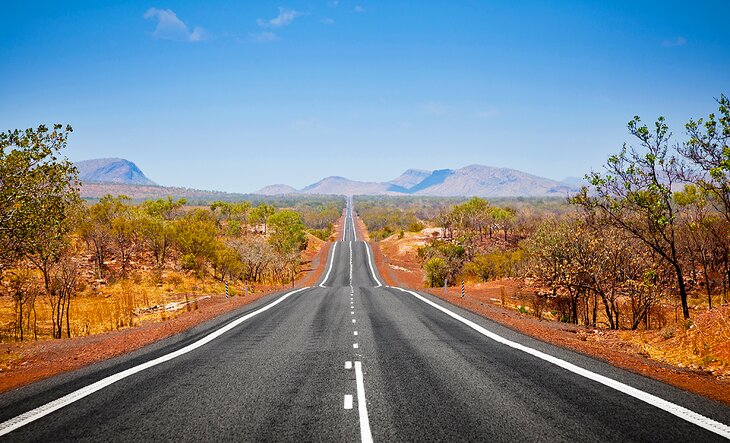
Australia is also a land of staggering contrasts and spectacular beauty. Along the coast, you can explore vibrant cities, vast sand islands, and one of the planet's most awe-inspiring natural wonders: the Great Barrier Reef. In the Outback, rugged national parks and remote deserts offer the ultimate travel adventures rich with Indigenous history.
Top it all off with a laid-back feel and friendly people, and it's no wonder Australia scores top billing on bucket lists around the world. Bring your travel dreams to life and plan the best places to visit with this list of the top attractions in Australia.
Sydney Opera House, New South Wales
Great barrier reef marine park, queensland, uluru-kata tjuta national park, northern territory, sydney harbour bridge, new south wales, blue mountains national park, new south wales, melbourne's culture, victoria, bondi beach, new south wales, daintree national park, queensland, k'gari (fraser island), queensland, kakadu national park, northern territory, great ocean road, victoria, broome, western australia, kangaroo island, south australia, cradle mountain-lake st. clair national park, tasmania, horizontal falls & the kimberley region, train trips across the outback.
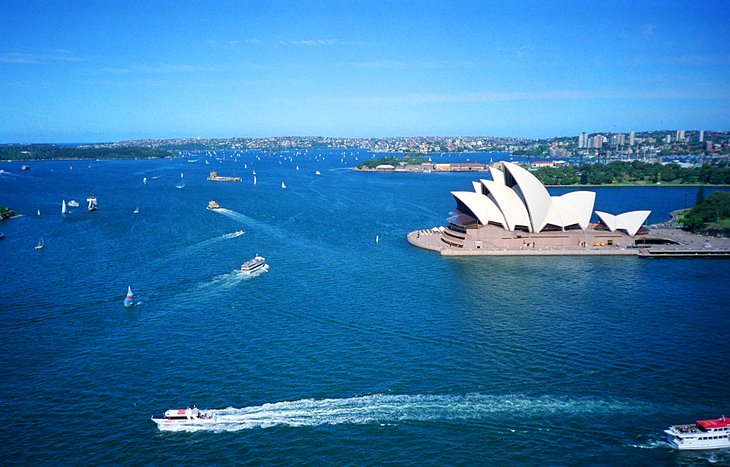
Mention "Sydney, Australia" and most people think of the Opera House. Shaped like huge shells or billowing sails, this famous building on Sydney's Bennelong Point graces the list of UNESCO World Heritage Sites and is one of the world's great architectural icons.
The location is stunning. Water surrounds the structure on three sides, and the Royal Botanic Gardens border it to the south.
Danish architect, Jørn Utzon won an international competition for its design but withdrew from the project after technical and financing problems. Construction was finally completed in 1973 at a cost of 10 times the original budget. By this time, Utzon had left the country, never returning to see his magnificent creation.
Today, you can enjoy a performance here, dine at one of the restaurants, or see the highlights of the Sydney Opera House on a guided tour. The structure encompasses theaters, studios, a concert hall, exhibition rooms, and a cinema.
Touring the interior of the Sydney Opera House is rewarding, but its striking architecture is perhaps best appreciated from a distance. One of the best sites to photograph this top Sydney tourist attraction is Mrs Macquarie's Chair in the Royal Botanic Gardens. Better still, hop aboard a harbor cruise or ferry and capture a photo from the water as you glide past.
In 2023, the Sydney Opera House is celebrating its 50th anniversary with a packed calendar of special events. During your visit, be sure to check out the newly renovated Concert Hall, part of an almost $300-million "Decade of Renewal."
Author's Tips: If you're visiting Sydney in late May/early June, you can see the white sails of the opera house light up after dark at the Vivid Sydney festival each year.
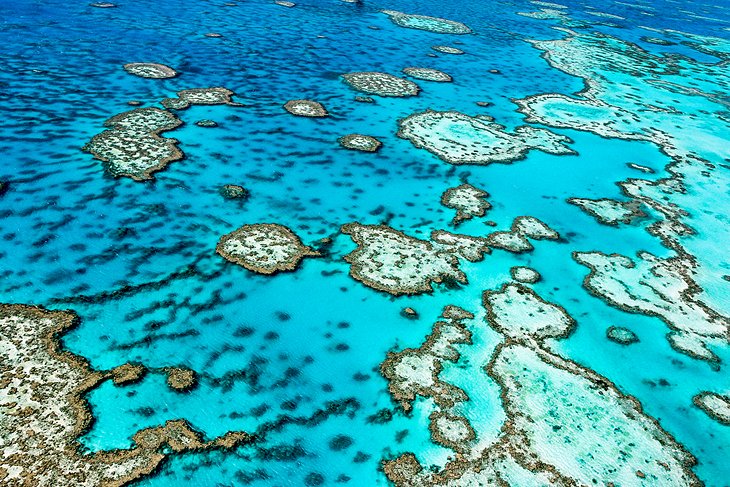
You can't leave Australia without seeing the Great Barrier Reef. This World Heritage-listed natural wonder is one of the largest living structures on the planet . It's so vast, you can see it from outer space. For divers, snorkelers, island aficionados, and nature lovers, it's a bucket list destination .
In 1975, the Great Barrier Reef Marine Park was established to protect its fragile ecosystems. These include more than 3,000 coral reefs; 600 continental islands, including the beautiful Whitsunday group ; 300 coral cays; and inshore mangrove islands.
One of the seven wonders of the natural world , the park stretches for 2,300 kilometers along the state of Queensland, on Australia's east coast (that's about the distance between Mexico and Vancouver).
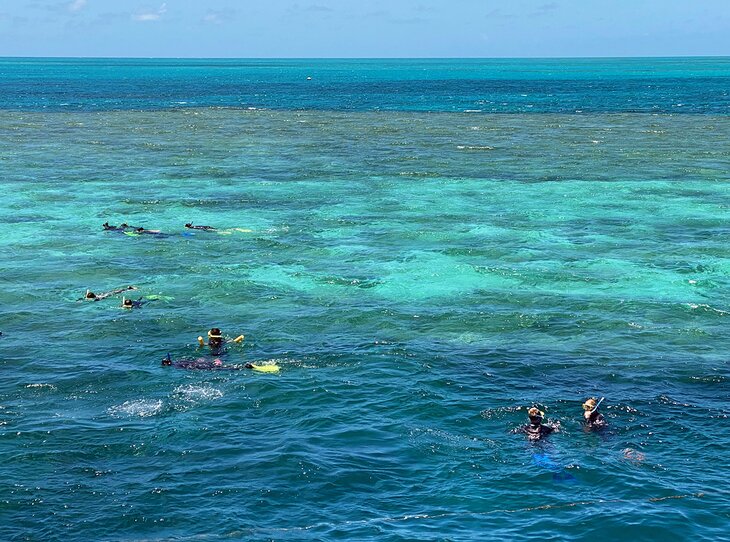
Not surprisingly, the Great Barrier Reef is one of the best places to visit in Australia for diving and snorkeling. The astounding array of marine life includes soft and hard corals, more than 1,600 species of tropical fish, sharks, dugongs, dolphins, turtles, rays, and giant clams. Prefer to stay dry? You can see the reef from underwater viewing stations and glass bottom boats.
Travelers have many options for visiting the Great Barrier Reef . You can cruise around the islands, hop aboard a sightseeing flight, take day trips to the islands, or snorkel and dive the reefs. On the mainland, the main launching points for tours are Cairns , Port Douglas , and Airlie Beach .
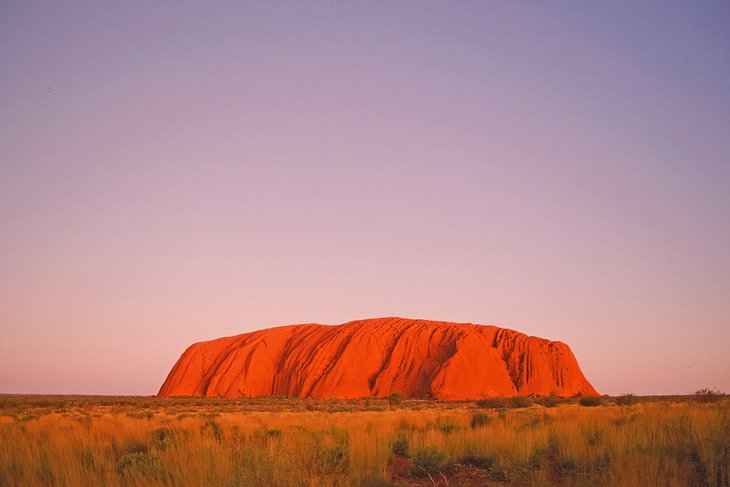
Deep in the heart of Australia's Red Centre, Uluru ( formerly Ayers Rock ), is one of the most photographed natural wonders in the country. The striking red monolith forms the centerpiece of Uluru-Kata Tjuta National Park , a World Heritage Site jointly managed by Parks Australia and the traditional landowners, the Aṉangu people.
Uluru, meaning "shadowy place" in the local Aboriginal dialect, rises to a height of 348 meters from the surrounding plain. Most of its bulk is hidden beneath the Earth's surface.
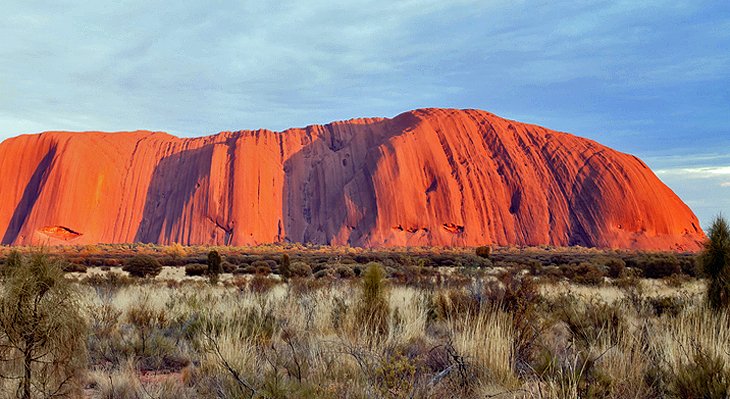
Also in the park, about a 30-minute drive from Uluru, are the red dome-shaped rocks called Kata Tjuta (formerly called the Olgas). Equally impressive as their more famous neighbor, and often less crowded, they should not be missed while you are in the park. You can admire their beauty on the 2.6-kilometer-return trek to Walpa Gorge or the 7.4-kilometer Valley of the Winds circuit.
Prime time for photographing these striking landforms is at sunset, when visitors gather to watch the colors of Uluru and Kata Tjuta transform in the shifting light.
Note: In 2019, the Uluru–Kata Tjuta National Park board outlawed climbing Uluru out of respect for the Anangu people, the traditional owners. The best way to appreciate these sacred sites is on walks led by Aboriginal guides and rangers.
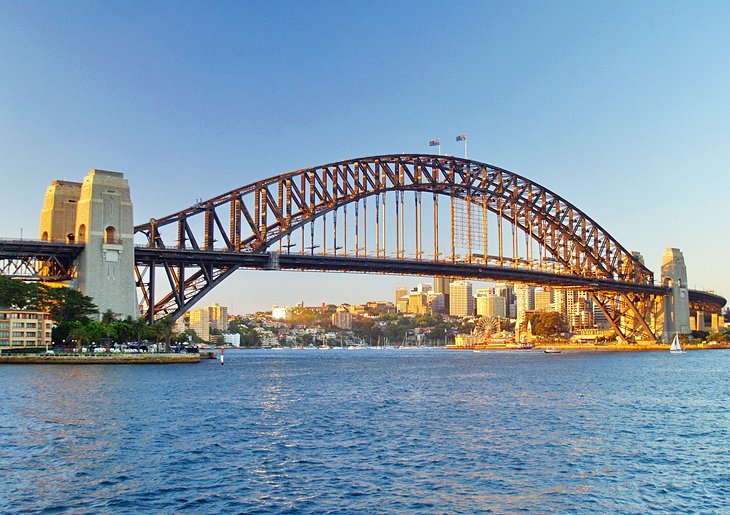
Along with the Opera House, the Sydney Harbour Bridge is one of Australia's top architectural icons. Affectionately called "the Coathanger," this impressive feat of construction is the largest steel arch bridge in the world . It was completed in 1932, 40 years before the Sydney Opera House.
Rising 134 meters above the harbor, the bridge spans 500 meters, connecting Sydney's North Shore to the central business district. In addition to the pedestrian path, two railway lines extend over the bridge, as well as eight lanes for road traffic, and the direction of each lane can be switched to accommodate traffic flow.
One of the top things to do in Sydney is a guided ascent to the top of the bridge. Standing on its summit, connected only by a carabiner, you can breathe in spectacular 360-degree views of the harbor and city. It's a great way to truly appreciate the layout of the city as you gaze out over the fingers of water that snake their way into beautiful blue bays.
For an overview of the bridge's history and construction, visit the museum on the southeastern pier.
Fun fact: Paul Hogan, of Crocodile Dundee fame, worked as a painter on the bridge before rocketing to international stardom.
Read More: Top-Rated Tourist Attractions in Sydney
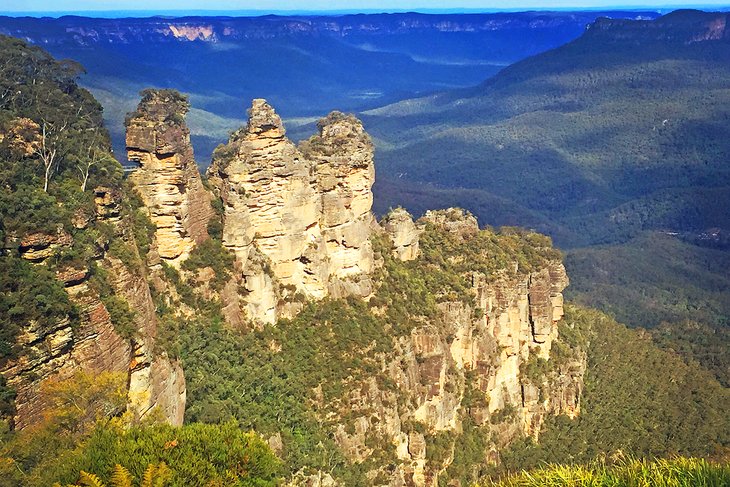
A UNESCO World Heritage Site , beautiful Blue Mountains National Park is a hiker's paradise and a popular day trip from Sydney . It lies an easy 81-kilometer drive west of the city.
Named for the blue haze emanating from the many eucalyptus trees, this stunning park protects more than 664,000 acres of wilderness. On a visit here, you can explore dramatic gorges, waterfalls, Aboriginal rock paintings, and 140 kilometers of hiking trails.
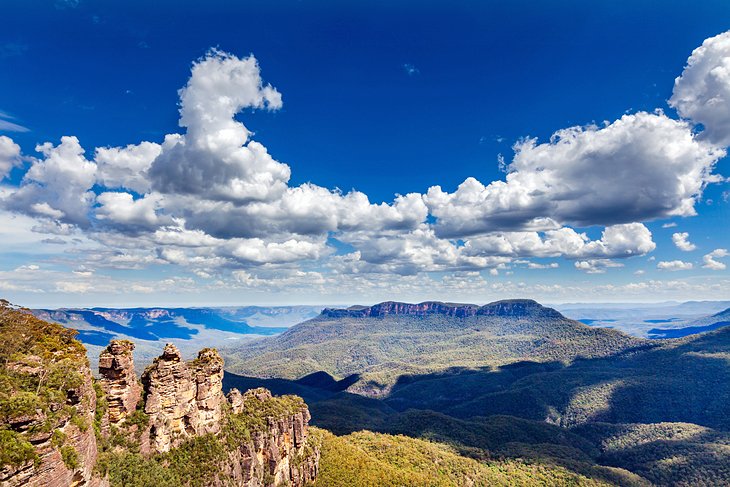
The most famous attractions in Blue Mountains National Park are the towering sandstone rock formations called the Three Sisters . Other highlights include the Katoomba Scenic Railway , the world's steepest, which whisks passengers down the Jamison Valley through a cliff-side tunnel into an ancient rainforest; and the Skyway, Scenic Cableway, and Scenic Walkway, which all offer elevated views of the dense forests.
Hiking, abseiling, rock climbing, mountain biking, and horseback riding are all popular things to do in the park.
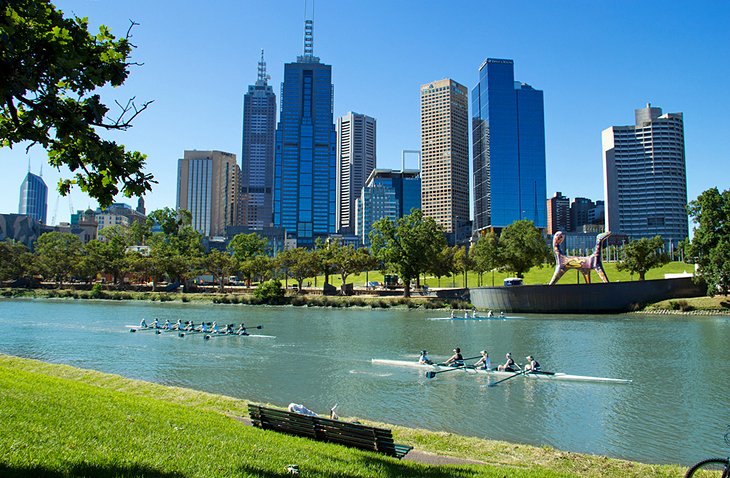
Melbourne, Australia's second-largest city, is a popular stop on many Australian itineraries — especially for culture vultures. Galleries, theaters, restaurants, shops, and its distinctly European feel are the main draws of this sophisticated city on the Yarra River.
It's also a green city, with parks, gardens, and open spaces occupying almost a third of its total area.
The cultural highlights of Melbourne are many. Gape at the masterpieces at the National Gallery of Victoria , watch a performance at Arts Centre Melbourne , or head to Federation Square . Here, you can browse Australian artworks at the Ian Potter Gallery and learn about the nation's screen culture at the Australian Centre for the Moving Image (ACMI) .
Feel like getting back to nature? Follow the Aboriginal Heritage Walk at the Royal Botanic Gardens . And if sports culture is top of your agenda, catch a game at the Melbourne Cricket Ground . In summer, cricket is the sport of choice; in winter, it's Australian Rules football.
Melbourne is also rich in history. You can see it in the Grand Victorian buildings funded by the Gold Rush, and you can feel it as you shop in the elegant arcades and Queen Victoria Market , which has been selling goods to Melburnians for over a century.
Read More: Top-Rated Tourist Attractions in Melbourne
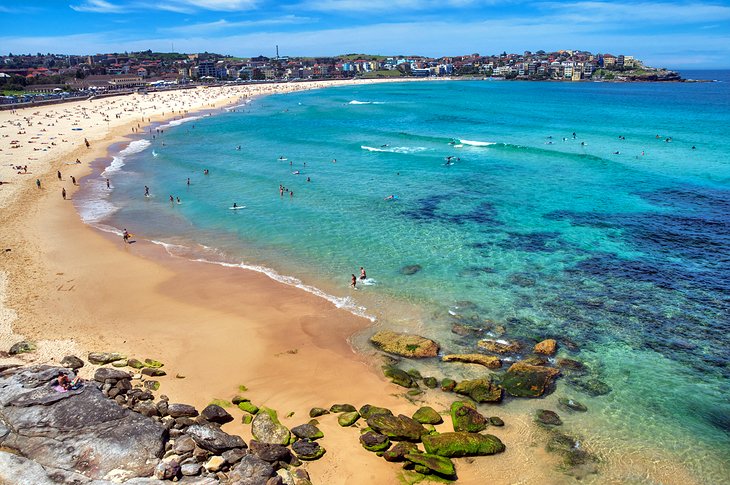
Bronzed bodies, blond sand, backpackers, and surf — throw it all together and you get one of the world's most famous beaches. Only 15 minutes by car from Sydney's city center, Bondi Beach is a great spot for a taste of Sydney's beach culture. Bask on the golden sands, surf the breaks, or take a cool dip on a hot summer's day (but stay between the flags).
Few cities in the world lay claim to such an enticing slice of sand and sea so close to the city. No wonder it's one of Sydney's best beaches . And you'll find some history here, too: Bondi hosts one of the oldest Surf Life Saving Clubs in the world .
Away from the shore, you'll find plenty of things to do in Bondi. Take a stroll along the Bondi to Bronte coastal walk. It begins at the southern end of the beach and follows the coastline for six scenic kilometers along sandstone cliffs. You can also hunt for bargains at the Sunday markets or swim some laps in the ocean pool. And if you work up an appetite, you'll find plenty of cafés and restaurants nearby.
One of the best places for a meal with a view at Bondi Beach is the famous Icebergs dining room. The menu spotlights modern Italian cuisine, and you can enjoy a meal of fresh-cooked fish watching the waves wash over the ocean pool.
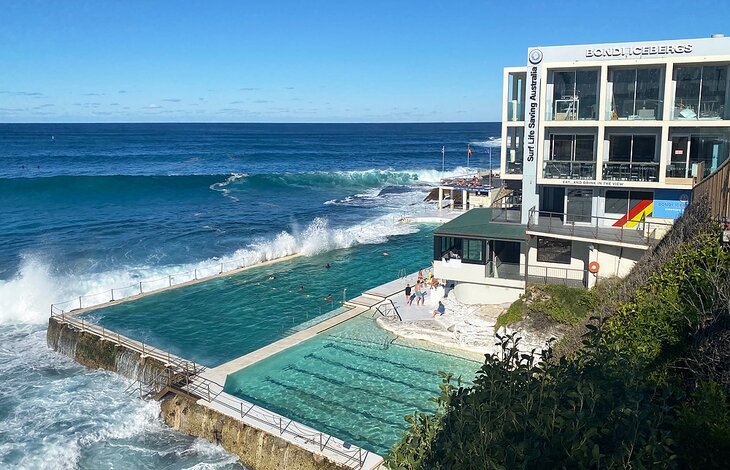
Bondi also has a wild side. Crowds of tourists and locals gather here to celebrate Christmas and ring in the New Year. It's a favorite spot for travelers.
A word to the wise: If you're taking a dip at Bondi, make sure you swim between the red and yellow flags. Strong rip tides often sweep unsuspecting swimmers out to sea, especially at the southern end of this kilometer-long strand. There's a reason the Aussies made a reality TV show called Bondi Rescue .
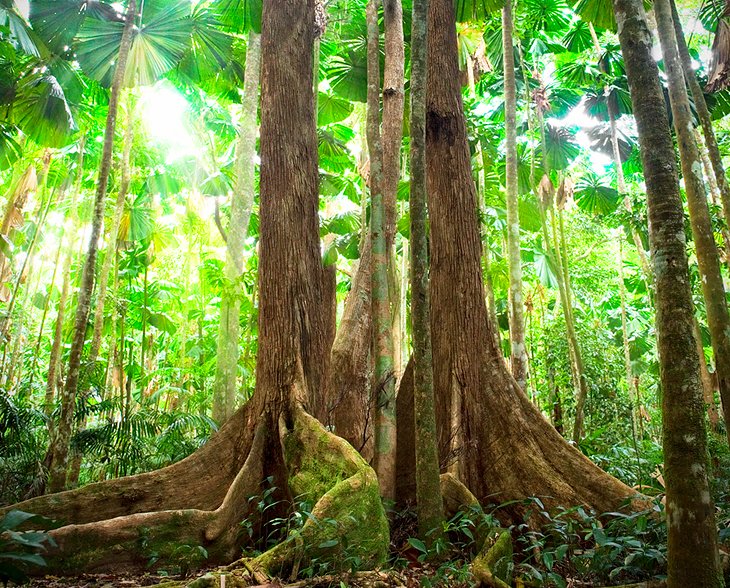
A Wet Tropics World Heritage Area , Daintree National Park in Far North Queensland is among the most ancient ecosystems on Earth. The area belongs to the Eastern Kuku Yalanji Aboriginal people, and many of its natural features hold great spiritual significance.
The park encompasses two main sections: Mossman Gorge, where crystal-clear waters gush over granite boulders, and Cape Tribulation, one of the most beautiful places to visit in Australia. Here, rainforest meets reef along the white sandy beaches of the Coral Sea. This stunning stretch of coast is one of the few places in the world where two of the planet's richest ecosystems converge.
The park's astounding biodiversity includes more than 18,000 plant species and a vast array of animal species, including the cassowary, crocodile, giant blue Ulysses butterfly, and the secretive Bennett's tree kangaroo.
The resort town of Port Douglas just south of the park, is a great base to arrange wilderness safaris into the park.
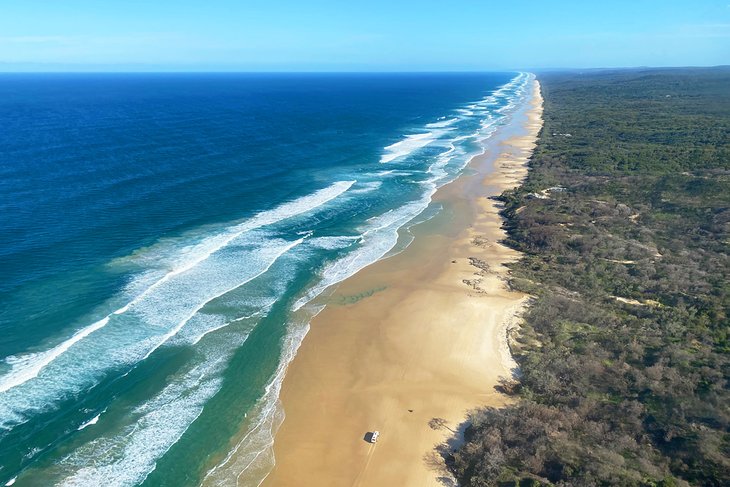
World Heritage-listed K'Gari (Fraser Island) is one of the most unique places to visit in Australia. Sitting between Bundaberg and Brisbane off Australia's east coast, this is the largest sand island in the world . Here, you'll find seemingly endless stretches of sand and sea, turquoise lakes, emerald rainforests, rippling dunes, and fascinating wildlife.
Looking for an adrenaline rush? A 4WD trip along its surf-thrashed shores is one of Australia's top outdoor adventures . Along windswept Seventy Five Mile Beach , you can see the rusted hulls of shipwrecks, the colored sandstone cliffs of The Cathedrals , and the bubbling fish-filled rock pools called Champagne Pools .
Thirty years ago, you could drive for miles and not see another soul. Today the beach can feel like a sandy highway, with a steady stream of 4WD vehicles and tourist buses plying the sands.
Venturing inland on the rugged tracks is a good way to escape the beach traffic during the peak summer months. Highlights include crystal-clear freshwater creeks and lakes, some fed by springs, others perched amid towering sand dunes; and ancient rainforests filled with an amazing diversity of plants and animals.
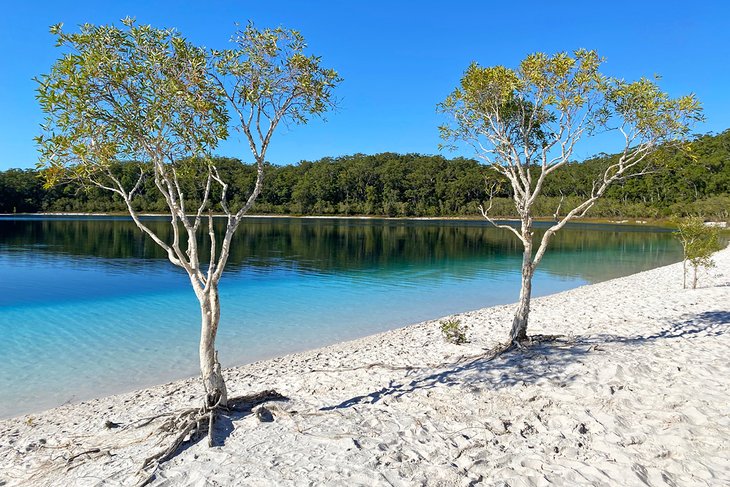
Sharks, dolphins, and whales swim these waters, and on land, you can see dingoes, bats, sugar gliders, and more than 300 species of birds.
Nature lovers will find plenty of other things to do on K'Gari Fraser Island . Hop aboard a whale watching trip, take a sunset cruise, hike the rainforest trails at Central Station , float down Eli Creek, or soar over the striking landscapes on a scenic flight.
Access to Fraser Island is by ferry from Rainbow Beach and Hervey Bay , the two main gateway towns. Four-wheel drive vehicles are essential, as the island has no sealed roads.
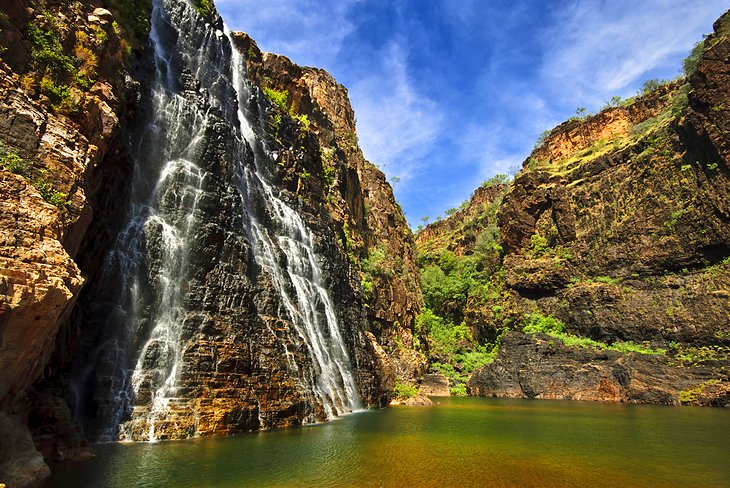
When it comes to wilderness areas, Kakadu National Park showcases the best of Australia. Covering more than 19,840 square kilometers in the Northern Territory, it's the second-largest national park in the world .
Within its borders, you can explore monsoon rainforests, mangrove swamps, rivers, gorges, ancient rock paintings, wetlands, and waterfalls.
Kakadu is also home to an astounding diversity of wildlife. In addition to the many mammals, reptiles, and fish, more than 300 different species of birds make their home here, and both freshwater and saltwater crocodiles lurk in the wetlands.
To explore the park's diverse ecosystems, hop aboard a cruise along the waterways, or hike the vast network of trails. You can also take a scenic flight.
Visiting Kakadu National Park from Darwin is easy during the dry season. It's about a three-hour drive from the Northern Territory capital. In the wet season (Nov-April), many roads and attractions close due to heavy flooding, but the waterfalls and wetlands can be at their best.
- Read More: Top-Rated Tourist Attractions in Australia's Northern Territory
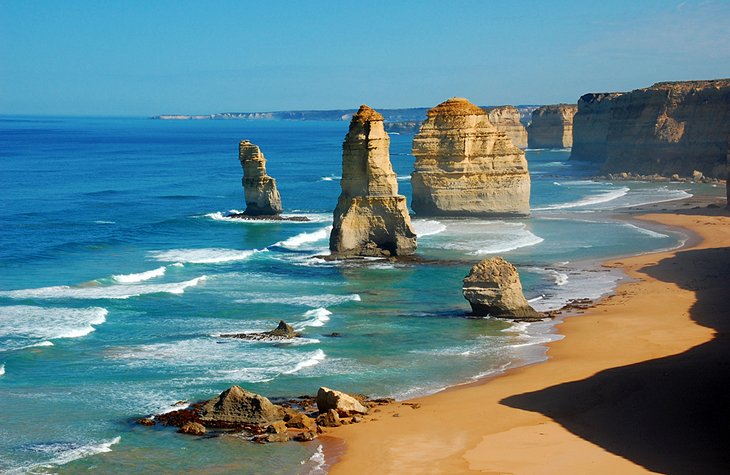
Great Ocean Road is one of the world's top scenic drives. Built to provide employment during the Depression, the road stretches for 300 kilometers along Australia's rugged southeast coast, winding along plunging sea cliffs. It stretches from the surfing town of Torquay to the town of Allansford , near Warrnambool .
One of the top attractions of Great Ocean Road is Port Campbell National Park . This is where you can see the wind- and wave-sculpted rock formations known as the Twelve Apostles , London Bridge , the Arch , and Loch Ard Gorge . From the air, these rock formations look like giant puzzle pieces adrift along the coast, lashed by the pounding surf of the Southern Ocean.
You'll find plenty of rewarding things to do along Great Ocean Road. Stop by the Australian National Surfing Museum at Torquay, surf the famous swells at Bells Beach, linger in the seaside resort of Lorne, or go whale watching in Warrnambool .
Nature lovers will also enjoy exploring the eucalyptus forests, fern-filled rainforests, hiking trails, and waterfalls in Otway National Park .
Author's Tip: If you're short on time, my favorite way to experience Great Ocean Road is on a helicopter ride along the coast. Gazing down at the giant rock formations carved from the coast by wind and water is a humbling experience. Lashed by the pounding surf of the Southern Ocean, the rock formations look like giant puzzle pieces adrift on a turbulent sea.
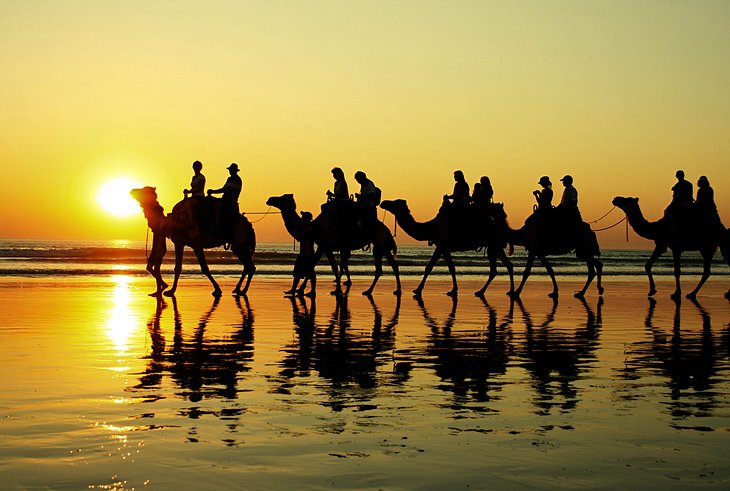
Broome, in Western Australia's north, was once the pearl capital of the world. Today, it's a booming tourist town and the gateway to the spectacular Kimberley region.
Broome's star tourist attraction is Cable Beach. This seemingly endless stretch of white sand and turquoise water is one of Australia's best beaches , and riding camels at sunset is one of the most popular things to do here.
Tourists also flock to Town Beach to witness the Staircase to the Moon. This phenomenon occurs during certain conditions between March and October, where the moonlight creates an optical illusion of steps leading to the moon.
Other Broome highlights include the red cliffs of Gantheaume Point, and the Malcolm Douglas Crocodile Park, where you can get up close to crocs, cassowaries, and kangaroos. If you're looking for things to do in town, you can brush up on some local history at the Broome Historical Museum or catch a movie in a deck chair under a star-studded sky at Sun Pictures.
Pearl farm tours, whale watching trips, and Kimberley adventures are also high on the things-to-do list in Broome.
- Read More: Top-Rated Tourist Attractions in Western Australia
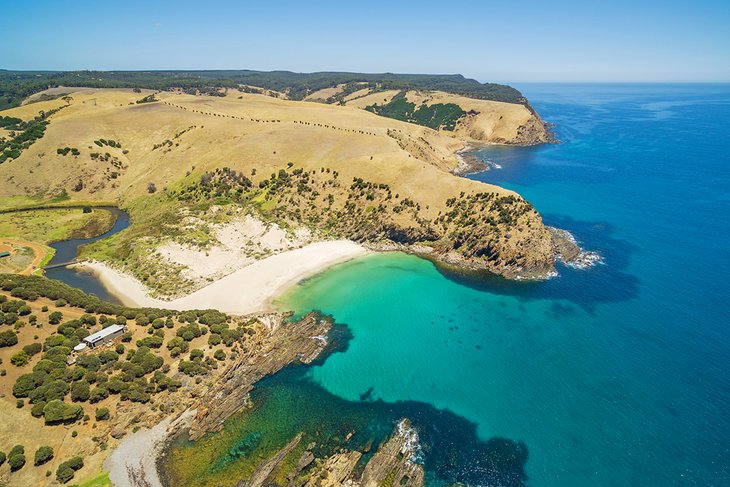
Nature takes center stage at Kangaroo Island. On this unspoiled island off South Australia's Fleurieu Peninsula, kangaroos hop along the powdery shores, sea lions and penguins frolic in the crystal-clear waters, and koalas cling to the fragrant eucalyptus trees.
Diving is also excellent. You can spot sea dragons in the temperate waters, and dive shipwrecks off the island's coast.
Kangaroo Island's top attractions are made by Mother Nature. See the striking, wind-sculpted rock formations, known as the Remarkable Rocks and Admirals Arch in Flinders Chase National Park . Explore vast cave systems. Surf towering dunes and look for wildlife on scenic hiking trails along soaring sea cliffs and through pristine forests.
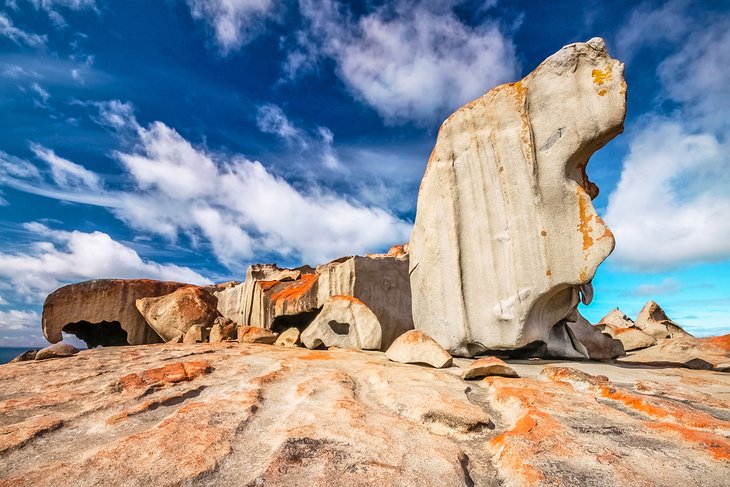
Foodies, too, will be in heaven. Creamy cheeses, Ligurian honey, and fresh seafood grace the plates in local restaurants.
To get here, you can fly direct to the island from Adelaide, or catch a ferry from Cape Jervis on the Fleurieu Peninsula.
Kangaroo Island is recovering well from the 2020 bushfires. In fact, several new eco-friendly lodges are slated to open here in 2023.
- Read More: Top-Rated Tourist Attractions in South Australia
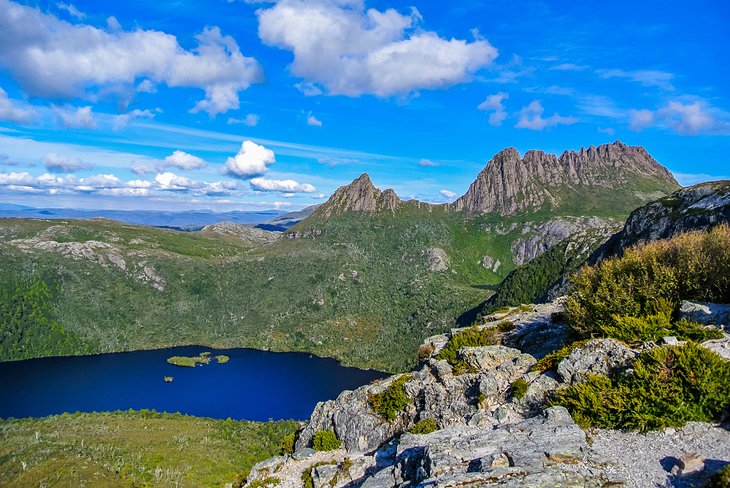
Cradle Mountain-Lake St. Clair National Park is one of Tasmania's tourism treasures and a nirvana for nature lovers. Sparkling lakes, serrated dolerite peaks, alpine heathland, and dense forests characterize the raw, glacier-carved wilderness here. One of the park's most distinctive features is the 1,616-meter Mount Ossa , the highest point in Tasmania.
As you might expect, hiking here is fantastic. Favorite trails include the Weindorfer Walk , a six-kilometer loop through dense forests, and Lake Dove Walk , with breathtaking vistas of Cradle Mountain (1,545 meters). Stand on the summit of Cradle Mountain, and you can soak up stunning views of the central highlands. Experienced hikers can also tackle the famous 80-kilometer Overland Track , which runs south from Cradle Valley to stunning Lake St. Clair , Australia's deepest lake.
While you're exploring the park, keep an eye out for Tasmanian devils, wombats, wallabies, pademelons, and platypus among the many species of weird and wonderful wildlife.
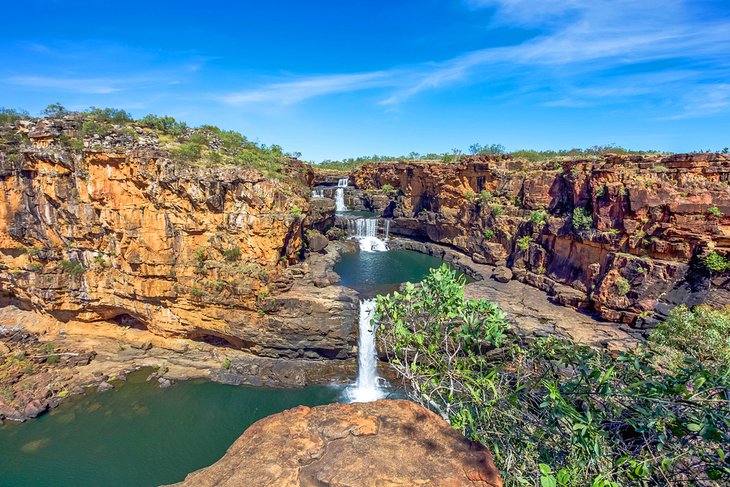
Adventures abound in the Kimberley. Covering Australia's northwest corner, this remote and rugged region of red rocks, gaping gorges, scorched deserts, and cliff-fringed coast is ripe for exploring.
One of the top adventures in the Kimberley is the Horizontal Falls. Powerful tides of up to 11 meters gush through two narrow gorges, creating this jaw-dropping phenomenon. Hop aboard a jet boat and zoom across the sea through the seething falls.
Broome is the gateway. From here, you can soar along scarlet sea cliffs and gaze down upon the 800-plus islands of the Buccaneer Archipelago. Fly farther north to the wild beaches of Cape Leveque, and visit remote pearl farms and Aboriginal communities. Take a 4WD safari along the Gibb River Road , one of Australia's most famous 4WD tracks.
The Kimberley is also home to the spectacular Mitchell Falls and UNESCO-listed Purnululu (Bungle Bungle) National Park . These spectacular beehive-shaped rock formations were only discovered in 1983. Hike the trails, visit sacred Aboriginal ceremonial sites and rock paintings, or soar over the park on a scenic flight and visit the Argyle Diamond mine.
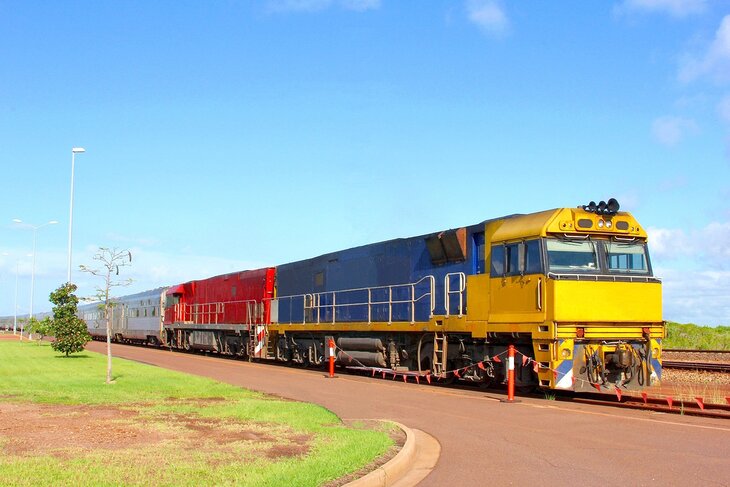
Driving through the Outback can be tough logistically — the distances are vast across this sun-scorched desert region, and you can drive for days without seeing another soul. But gliding through on a luxury train makes exploring Australia's red-hot heart a breeze. It's also a great way to see multiple Aussie attractions in one trip.
You have several train trips to choose from depending on where you want to go. One of the best is the Indian Pacific , Australia's longest train journey. This four-day luxury train trip travels between Perth, Adelaide, and Sydney, whisking you across three states in four days.
Highlights include the Blue Mountains, Broken Hill's art galleries, South Australia's pink lakes, the seemingly neverending Nullabor Plain, and a series of mouthwatering foodie experiences. You can also upgrade your experience with a post-trip tour of vibrant Perth.
Hop aboard The Ghan for another iconic Aussie train trip. From the comfort of a luxury cabin, you can gaze out on the elemental beauty of the desert, while you traverse some of the most remote areas in Australia, including the opal-mining town of Coober Pedy and the Flinders Ranges. Choose between three different routes : Adelaide to Darwin (three days and two nights), Adelaide to Alice Springs (two days and one night), or Darwin to Alice Springs (two days and one night). All these trips can also be taken in reverse.
And if a shorter trip is more your style, opt for the Spirit of the Outback . This 26-hour journey travels from Brisbane to Longreach , in Outback Queensland, where you can delve into some Aussie nostalgia at heritage mining towns like Blackwater and Emerald and visit the Stockmen's Hall of Fame in Longreach.

More on Australia
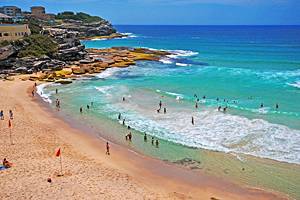

- TOP CATEGORIES
- AS and A Level
- University Degree
- International Baccalaureate
- Uncategorised
- 5 Star Essays
- Study Tools
- Study Guides
- Meet the Team
- English Literature
- Fyodor Dostoevsky
Travel Writing Australia
Michael Finch RPF
Travel Writing Coursework
It’s the driest, hottest, most infertile and climately aggressive of all the inhabited continents, home to the most dangerous animals on the planet.
Australia is a country tanned red by the scorching sun that beams down endlessly throughout the year like the sea lapping gently against the shoreline. With a population of only a third of England, shared between six cities, to Australians anything vaguely rural is the bush. At some undetermined point this becomes the outback, push for a further 2,000 miles and eventually you come to the bush again, then a city, then the sea. That’s Australia.
Sydney is situated in the foothills of the Blue Mountains whose rocky outcrops provide a dramatic backdrop to the city. It is a warm and friendly city where the people are cheerful, extrovert and quick-witted, apart from a tendency among men of a certain age to wear knee-high socks with shorts.

After the bustle of cosmopolitan Sydney, I headed for the Blue Mountains, so named for the blue tinged haze shimmering in the valleys as the sun reflects off oil droplets from the eucalyptus trees. This was a relatively short bus journey of 90 minutes. Approaching the mountains I wasn’t quite sure what to expect from a cluster of rock formations lined with a few trees. However once I arrived at the spectacular mountains, I was taken back by the beautiful scenery and fresh air by the lungful.
This is a preview of the whole essay
We started our journey in Katoomba and almost immediately we set off down an endless, dusty and rocky path, eroding it as we walked, step by step. Eventually we came to a clearing. I was suddenly hit by the intense smell of the eucalyptus oil that lingers in the air like stagnant smoke. Then I caught a glimpse of a great mechanical device which ventures across the steep valley to the plateau, hundreds of metres away. The cable car sways from side to side in a hypnotic fashion, as if it were trying to put you into a deep trance.
My mother being a chronic sufferer of vertigo was less than keen on the idea of being suspended 300m above the picturesque valley, with her life hanging in the balance, all for the sake of some 6x4 photos.
The 3 sisters, a famous rock formation, were however on a grand enough scale to be seen without the aid of a cable car. The aboriginal legend behind their occurrence has it, that 3 sisters of the Katoomba tribe had fallen in love with 3 brothers of the Nepeen tribe. Their tribal laws forbade them to marry; this then led to tribal battle. As the 3 sisters were in danger a witchdoctor took it upon himself to protect them, so he turned them into stone to keep from harm. He had intended to turn them back but he himself was killed in battle. It was only he who could return the sisters to their former beauty, so they remain in their rock cocoons as a reminder of the battle.
Sadly, after a matter of what seemed minutes, I had to leave Katoomba. This was a tranquil and charming little village with countless arty-crafty shops selling a variety of didgeridoo’s camouflaged by intricate aboriginal art. After a few minutes drive we stopped off for a last glance at the mountains and a tea break, with a difference. Our tour guide, a typical Aussie, told us how to make ‘real’ tea. We first picked the tea leaves and put them in a billy can, teapot to us Brits, then pinched a few eucalyptus leaves of a near by tree and added them to sweeten the tea. He then placed it on a fire. I stood watching in amazement, half expecting him to whip out a quaint little sieve, and for us all to drink with our little fingers pointing upwards. As you may have guessed, this wasn’t quite how they did it in the mountains. Once all the ingredients were in the billy can our guide began to talk us through the process of ‘swinging the billy’ in a classic Australian drawl.
“Right then first we grab the billy and start the swinging motion, watch yourself it’s hot! Now we swing it right ‘round, that should settle the leaves to the bottom. And that’s what we call swinging the billy!! Now for you Brits there’s milk over there, why’d you wanna spoil a perfectly good cuppa tea, is beyond me!”
Back to the restless city, it takes a while for your senses to adjust to the dazzling lights and the constant buzz, occasionally interrupted by sirens and car horns. Although I'm glad to be back in Sydney a part of me will miss the peace and serenity that was the Blue Mountains.

Document Details
- Word Count 815
- Page Count 2
- Level AS and A Level
- Subject English
Related Essays

Travel writing.

Creative Writing Coursework 'Rebirth'.

Creative Writing : Away

The extract taken from the Australian novel, 'The Battlers' is the opening...
- Tools and Resources
- Customer Services
- African Literatures
- Asian Literatures
- British and Irish Literatures
- Latin American and Caribbean Literatures
- North American Literatures
- Oceanic Literatures
- Slavic and Eastern European Literatures
- West Asian Literatures, including Middle East
- Western European Literatures
- Ancient Literatures (before 500)
- Middle Ages and Renaissance (500-1600)
- Enlightenment and Early Modern (1600-1800)
- 19th Century (1800-1900)
- 20th and 21st Century (1900-present)
- Children’s Literature
- Cultural Studies
- Film, TV, and Media
- Literary Theory
- Non-Fiction and Life Writing
- Print Culture and Digital Humanities
- Theater and Drama
- Share This Facebook LinkedIn Twitter
Article contents
Australian travel writing, 1900–1960.
- Anna Johnston Anna Johnston University of Queensland
- https://doi.org/10.1093/acrefore/9780190201098.013.312
- Published online: 28 June 2017
Travel writing has been an important form through which Australians learned about their own culture and their place in the world. Indigenous cultures of place and travel, geographic distance from the imperial metropole, and a long history of immigration have each made travel a particularly influential cultural practice. Nonfictional prose narratives, based on actual journeys, have enabled travelers in Australia and from Australia abroad to explore what was distinctive and what was shared with other cultures. These are accessible texts that were widely read, and that sought to educate and entertain their audience. The period from the inauguration of the Australian nation in 1901 to 1960, when distance shrank because of technological innovation and new forms of identity gained ascendance, shows the complex ways in which Australians defined their country and its global contribution. Writing about travel to Britain and other European locations helped authors to refine the Anglophone inheritance and a sense that Britain was Home. Northern-hemisphere travels also made some writers intensely feel their national identity. Participation in global conflicts during this period shifted Australian allegiances, both personal and governmental. At the same time, a new tourist industry encouraged Australians to travel at home, in order to learn more about remote areas and the Asia-Pacific region. Travel writing both abroad and at home reveals how particular forms of emotional allegiance and national identity were forged, reinforced, and maintained. This has been a particularly influential genre for a nation based on colonial migration and indigenous displacement, in which travel and mobility have been crucial.
- travel writing
- print culture
- colonial literature
- World War I
- World War II
You do not currently have access to this article
Please login to access the full content.
Access to the full content requires a subscription
Printed from Oxford Research Encyclopedias, Literature. Under the terms of the licence agreement, an individual user may print out a single article for personal use (for details see Privacy Policy and Legal Notice).
date: 12 September 2024
- Cookie Policy
- Privacy Policy
- Legal Notice
- Accessibility
- [66.249.64.20|81.177.182.154]
- 81.177.182.154
Character limit 500 /500
News for Kids
- Dominican Republic
- Netherlands
- New Zealand
- Papua New Guinea
- Philippines
- Puerto Rico
- Solomon Islands
- South Africa
- South Korea
- Switzerland
- United Arab Emirates
- United Kingdom
- United States of America
- 7 Continents
- Australia/Oceania
- North America
- South America
- Chinese New Year
- Elections 2024
- Olympics 2024
- European Union
- Trivia & Quizzes
- Solar System Quiz
- Travel Reviews
- Travel Health
- Travel Links
Competition 2024
- Winners 2023
- Winners 2022
- Winners 2021
- Winners 2020
- Winners 2019
- Request A Correction
Australia Facts
Australia for kids.

Here are some interesting Australia Facts which were chosen and researched by kids especially for kids.

- Name : Commonwealth of Australia
- Government : Democracy
- Population : About 26.4 million (2023)
- Urban Population : 90%
- Capital : Canberra with 472,000 people
- Language : English
- Unemployment : 12%
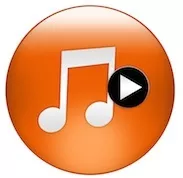
- Currency : 1 Australian dollar ($) = 100 cents
- Religion : mainly Christians
- Timezones : 3
- National Symbols : Golden wattle (flower), opal (gemstone), green and gold (colours) and the Commonwealth Star (a seven-pointed star)
- National Animals : Kangaroo, emu
- National Holiday : 26 January (Australia Day)
- National Anthem : Advance Australia Fair
Australia Geography Australia Maps
Australia is an island country in the Southern hemisphere and belongs to Oceania/Australia. Australia is referred to as country and as continent as the country sits on its own continental shelf. The country is surrounded by the Indian Ocean and the Pacific Ocean.

Australia is the smallest continent of the seven continents. The continent is often referred to as Oceania. Australia is one of the largest countries in the world while Greenland is considered the biggest island in the world.
Australia is also the driest inhabited continent of the world.
Did you know that Australia is the largest country in the Southern hemisphere and the largest country without land borders?
Australia is the sixth largest country in the world, after Russia, Canada , USA, China and Brazil .
The country is divided into six states (Southern Australia, Western Australia, New South Wales, Queensland, Victoria and Tasmania) and two self-governing territories: Northern Territory and Australian Capital Territory (which is around Canberra, the capital city).

The country's interior consists of arid and semi-arid areas which are referred to as 'outback'. About 70% of Australia are outback, while the coastal plains are more fertile and house the majority of Australia's population. About 35% of Australia's land area are covered by deserts.
Most of Australia's population live in the eastern and southern parts of the country and along the coastline.
Australia is roughly the same size as the USA without the states of California and Texas.
Australia belongs to the Commonwealth countries. Read more here.
10 Australia Superlatives
- The highest mountain of Australia is Mount Kosciuszko with 2,228 m/ 7,310 ft. This mountain is in the Great Dividing Range.
- The Great Dividing Range is the longest mountain range in Australia stretching over 3,500 km/ 2,175 miles.
- Uluru, previously referred to also as Ayers Rock, is located in the centre of the country and is the largest alone standing rock in the world.
- The longest river of Australia is the Murray River with 2,508 km/ 1,558 miles.
- The Great Barrier Reef in Eastern Australia is the biggest coral reef system in the world. The reef consists of more than 3,000 reefs and 900 islands. The Barrier Reef is home to over 350 species of corals and over 1,500 species of fish.
- Australia is the world's largest exporter of coal.
- Sydney is Australia's biggest city with more than 5 million inhabitants.
- Australia's largest desert is the Great Victoria Basin which covers most of Western Australia and South Australia.
- New South Wales is the most populous state of Australia. 65% of the country's population live in New South Wales.
- The largest state of Australia is Western Australia.
More about the most famous Landmarks of Australia here.
Australia Facts | Australian Cities
The biggest cities in Australia are Sydney, Melbourne, Perth, Brisbane and Adelaide. These cities are all located at the coast or close to the coast and are the only metropolitan cities in Australia with more than one million inhabitants.
Canberra is Australia's capital city and the only major city of the country further away from the coast. Canberra is located about 150 km/ 93 miles inland from the Pacific Ocean coastline and about 280 km/ 173 miles to the southwest of Sydney.

Read more about Australia's landmarks and attractions.
Australia Facts : Sydney is Australia's largest city with about 5 million inhabitants, which means that about 20% of all Australians live in this metropolitan city.
The main city in the country's interior is Alice Springs while Darwin is the biggest city in the Northern Territory.
Australia Facts Australia Attractions for Kids
There are many great attractions in the country. Some of these are - listed in alphabetical order:
- Adelaide : the main city in South Australia is home to about half a million people. Adelaide is surrounded by fertile agricultural land and wine regions. Did you know that Adelaide is also known for one of the largest Christmas parades in the world?

- Arnhem Land: The Northern Territory is home to a large population of aboriginal people who have a deep spiritual connection with the land and proudly will share their experiences with visitors.

- Australian Alps : Experience mountain landscapes with snowy mountain tops even in summer and enjoy the fascinating remote wilderness. There are lovely hiking tracks especially near lake Jindabyne.

- Brisbane: the city with over two million inhabitants is the centre of the Australian Gold Coast with numerous resorts for an exciting beach holiday and a bit further to the north, there is the wonderful coral reef you cannot miss!

- Great Barrier Reef : The world's largest coral reef is great for snorkelling and diving. Cairns is a popular beach resort town on the Northern Coast and Lady Elliott Island and Hamilton Island are wonderful family holiday islands.

- Melbourne : The second largest city of Australia is the main city of the state of Victoria and has lots of trendy restaurants, shops and art galleries along the Yarra River.

- Kakadu National Park : Experience the excitement of a real jungle in Australia's biggest national park and one of the world's most unique forests and woodlands and one of Australia's UNESCO World Heritage Sites. There you can also admire the Northern Territories highest waterfalls, the Jim Jim Falls.

- Perth : The biggest city in Western Australia also housing about two million people is known for its cultural scene and is close to lovely Fremantle which has historic quarters to explore. And don't forget Rottnest Island where you can meet the friendly quokkas, the unique wallabies. Read more here.

- Pinnacles Desert Park : Hundreds of limestone pinnacles can be seen in Nambung National Park in Western Australia. There you can also spot wild emus.

- Sydney : The iconic Opera House is one of the world's most famous landmarks. Then there is the Harbour Bridge, the magical setting of the Sydney Botanical Garden, Darling Harbour, The Rocks and so much more to explore.
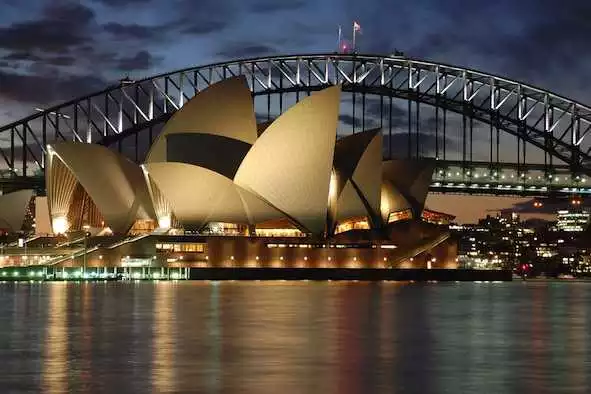
To read about Australian landmarks and the Top 10 Visitor Attractions in Australia, click here
Australia Facts | Australian People

Australia's first or indigenous people, are usually referred to as the aboriginal people of Australia. They make up 2% of Australia's population today. The indigenous Australians are said to be direct descendants of migrants from Africa who left the African continent about 75,000 years ago. They have migrated over the Australasian continent until they settled in Australia around 60,000 years ago.
Today aboriginal people live in all main cities in Australia but most of them still live in the desert areas of the Australian outback. On the image above, you can see a man playing the didgeridoo, a kind of wooden trumpet, which is really difficult to play. The aboriginal people are highly skilled in arts and crafts and share with visitors their vast knowledge about the land and the environment.
The 'outback' is the vast, dry and remote inland parts of the Australian continent. Some aboriginal people live still in the sacred area around Uluru, a huge rock formation in the centre of the continent.

Uluru was formerly referred to as Ayers Rock. Many groups of aboriginal people also live in the Northern Territory in Kakadu National Park, which they call 'Arnhem Land', the land of their ancestors.
Australia Facts | Australian Animals
Australia is h ome to many animal species. In fact, Australia houses more than 10% of the world's biodiversity (animals and plant varieties).
Among the most well-known Australian animals are kangaroos, wombats, koalas and the dingos.

Roadsigns in Australia warn drivers about wild animals mainly kangaroos that might cross the roads.
Kangaroos are marsupials, which means, they carry their babies in their pouches. See the cute little joey (this is how baby kangaroos are called).

Wombats are also marsupials. Wombats have sharp teeth, but are herbivores. This means they eat grasses, bark and roots. Wombats are mainly night-active, but can also be seen out looking for food on cool and overcast days, such as this wombat on the picture below.

Read more about the fascinating Australian wildlife on our special page here.

Australia Facts | Australia Quiz Test your knowledge
Read more about australia popular pages.
We hope you enjoyed these updated Australian facts :-)
Image credits on Australia Facts: Shutterstock.com and own images
Resources for Australia Facts Page:
- Central Intelligence Agency. "Australia." World Fact Book. Last update 21 June 2023. Last accessed 30 June 2023
- The Commonwealth. "Australia Facts." Commonwealth Secretariat . Last accessed 30 June 2023
- The Nature Conservancy. "Meet the Quokka." NatureAustralia.org . Last accessed 30 June 2023
- Tammy Solonec. Why saying 'Aborigine' isn't ok. 8 Facts about indigenous people in Australia. Amnesty International . 9 August 2015. Last accessed 30 June 2023
- Australia Government. Australia Covid and Travel Information. www.australia.gov.au . Last accessed 30 June 2023
Return from Australia Facts to KidsWorldTravelGuide Homepage
Competition 2024 is open!
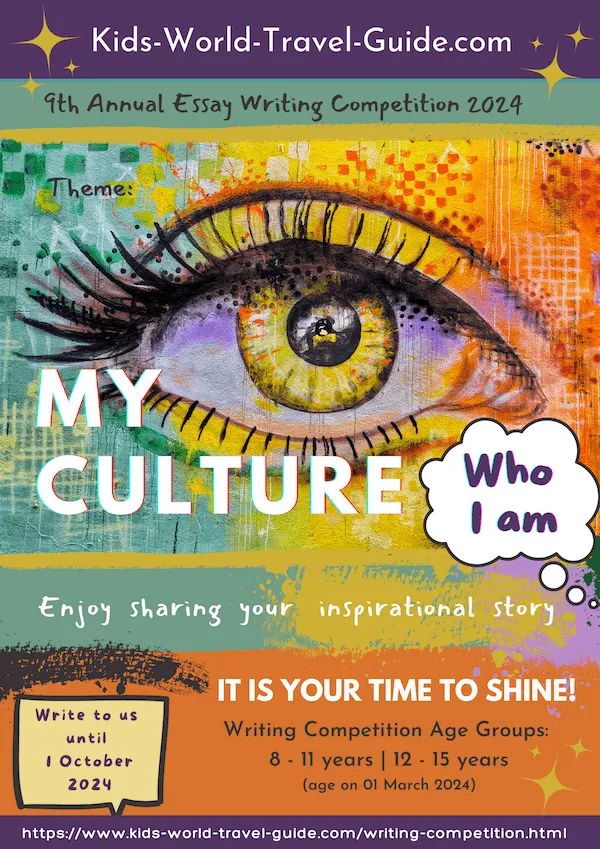
Would you prefer to share this page with others by linking to it?
- Click on the HTML link code below.
- Copy and paste it, adding a note of your own, into your blog, a Web page, forums, a blog comment, your Facebook account, or anywhere that someone would find this page valuable.
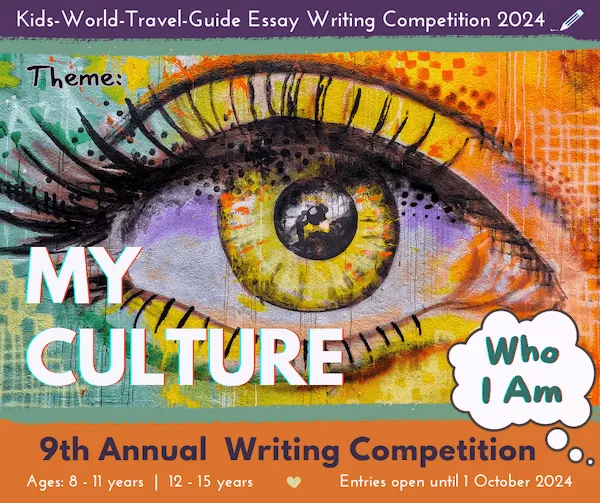
Events & Celebrations
Organisations, games & quizzes, travel tips, competition, recent articles.
Pacific Ocean Facts for Kids | Geography | Pacific Ocean for Kids
Sep 06, 24 10:07 AM
Facts about Tuvalu for Kids | Tuvalu Oceania | Geography | Pacific
Sep 06, 24 09:53 AM
Estonia Facts for Kids | Geography | Facts about Estonia | Baltics
Sep 03, 24 10:31 AM
More about Australia

About Oceania

Other Commonwealth Countries

Spread the Word

Winning Essays 2021
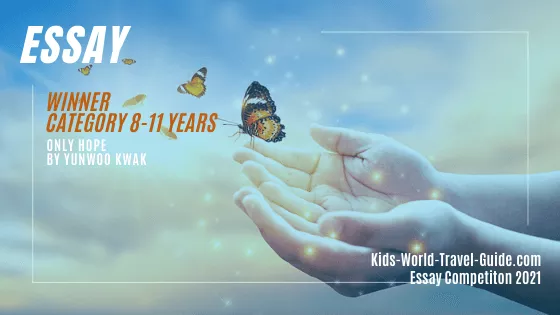
Winning Essays 2022
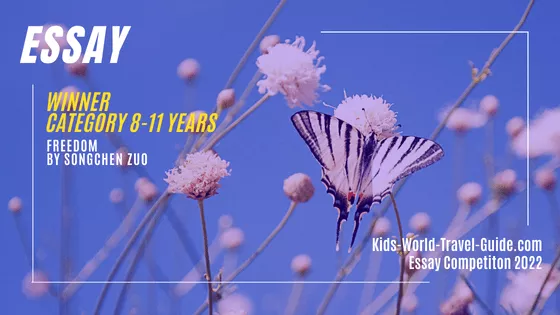
Like us on Facebook
Kids World Travel Guide
Brilliantly
Content & links.
Verified by Sur.ly
©Kids-World-Travel-Guide.com 2010-2024 | Created by Regina Gräff and KidsWorldTravels
All rights reserved | Privacy Policy | Disclaimer

- Destinations
- South Pacific
The most popular holiday destinations in Australia, according to our readers
By Kristine Tarbert | 2 days ago
9Travel and Today 's Aussie Travel Trends Index surveyed Nine audiences across TV, digital, print and radio, to find out your favourite travel destinations. Here are the results.
From sand and tropical rainforests to deserts and wide-open plains, Australia is home to some of the most stunning holiday destinations in the world.
But where do Aussies like to travel the most? We set out to determine which holiday destinations in the country were our favourite, asking our Nine audience to vote in our inaugural 9Travel survey the Aussie Travel Trends Index.
And while the number one destination was rather predictable, there were a few unexpected places filling the top spots.
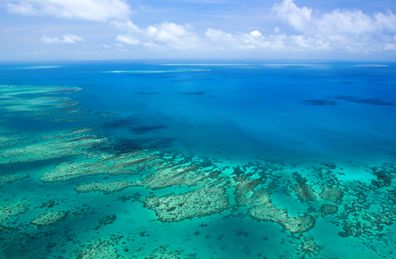
READ MORE: These are the best beaches in the world for relaxing
Our survey showed that people are travelling to various destinations across Australia, although eastern seaboard locations are the most popular.
As such, Far North Queensland was voted as the number one favourite holiday destination in Australia by our readers.
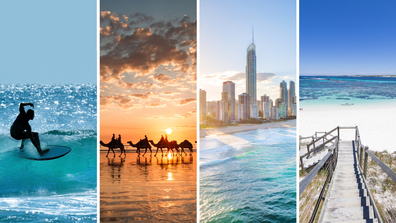
FNQ, of course, includes the world-famous Great Barrier Reef, as well as stunning coastal locations like Cairns and Cape York, the northern-most point of Australia.
All up, 32 per cent of respondents said Queensland was their favourite destination, but only slightly behind at 31 per cent, Melbourne came in a surprise second place.
READ MORE: 'I stayed in one of the most unique holiday home rentals in the NSW wine region'
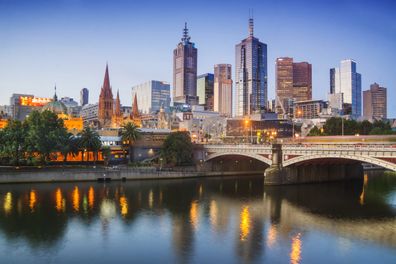
The Victorian capital was a far way ahead of its east coast rival Sydney, which came in sixth spot overall with only 22 per cent of respondents choosing it as their favourite holiday destination.
Third place went to another Queensland location, with the Sunshine Coast (home to Noosa) getting 26 per cent of votes.
Tasmania's capital Hobart, the ideal starting point for a trip around the beautiful state, came in fourth place. And the Great Ocean Road, a popular road trip in Victoria rounded out the top five.
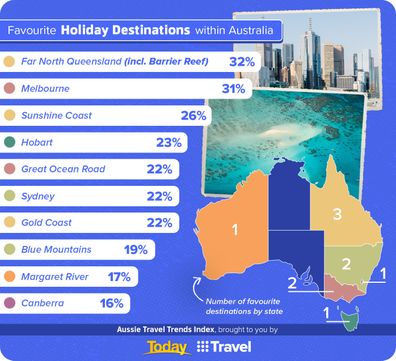
READ MORE: 'All the - slightly random - places I saw vending machines during a trip to Japan'
Other popular destinations included the Gold Coast in Queensland, the Blue Mountains in NSW, and the Margaret River region in Western Australia, proving Australians are keen to explore the whole country.
Outside of the top ten, destinations including Perth, Uluru, Kakadu and Byron Bay received on average 10-12 per cent of the votes.
Adelaide and the Barossa were also popular, receiving 13 and 14 per cent.
People were allowed to choose multiple options, but still there were 13 per cent of respondents who said they didn't have a favourite.
Stay tuned for more from our Aussie Travel Trends Index , brought to you by 9Travel and Today .

- Travel Survey
- Travel Planning
- Great Barrier Reef
Property News: Fixer-upper house for sale for $5.5 million in Sydney's Vaucluse.
/https%3A%2F%2Fprod.static9.net.au%2Ffs%2Feee08bff-e029-4e90-b9e4-445ea66b5721)
Hotel worker reveals 'red flag' that suggests you shouldn't stay

Port Douglas: The best spot in Australia for a relaxing trip

Here's everything you need to know about solo cruising

A fascinating and thoughtful essay on Australia’s decline and fall.
Author Unknown
When the history of the decline and fall of the great nation that was Australia is written, how will scholars trace its downward spiral? Will they tag that point at which a vast percentage of the workforce became so lazy and ill-disciplined that it could no longer entertain the thought of travelling to the workplace and demanded to work from home? Get up, shower, get dressed and walk to the bus stop? You must be joking. Employers, led by governments, buckled to their demands and what was a Covid-convenience became regarded as an absolute right. Lifestyle, the historians will note, became the worker’s mantra which superseded diligence and dedication with heavy penalties imposed on those bosses who dared contact an employee one minute after their official clock-off time. “More money, less work” they chanted as they logged off and stretched back on the couch. “More money, less work” said the unions and the government said “No worries, comrades” as productivity slipped lower and then lower again. Maybe they will chart it as beginning at that time when people became so lazy that they could no longer be bothered to prepare meals and instead headed for the nearest takeaway outlet and then, tiring of the effort involved in so doing, picked up their phones and had their calorie-laden meals delivered to their doors. More food, less effort they sighed, sinking once more onto the couch, and the nation got fatter and fatter and fatter. Perhaps the historians will chart this decline from the moment that a prime minister embraced lying as a virtue and the masses, in exchange for a handful of silver, nodded dumbly and pocketed the proffered coins. Others might wonder if the moral rot took hold when governments failed to act against the murderous, anti-Semitic outpourings from some Muslim clerics, fearful that if it did it might cost it votes in those electorates with a high proportion of Muslims. Most people, either ignorant or too self-obsessed to care, shrugged at these outrages and went back to moaning about the price of petrol and groceries. Holocaust? That’s history, mate. Nothing to do with me. It was when mobs roamed the streets, others might suggest, assaulting and robbing the innocent while the system supposed to deliver justice and protect them smiled and said: “They’re juveniles. They know not what they do. Release them” that the once great society began to crumble. It was the concept of two Australians, other historians might argue, that divided and weakened the nation’s underpinnings for a nation divided cannot but fall. As they trawl through the archives, they will find that the country became split between the Indigenous and the non-Indigenous, the former demanding special treatment and the latter sensing this went against the principles of democracy. These historians will pore over the results of the Voice referendum and wonder why, when the people had made their wishes clear, the demands for two classes of Australians to exist continued and with them demands for money and land. The governments folded and gave away more money and signed away vast tracts of the country, and the people’s discontent smouldered and their resentment grew. Scholars might also note that the nation began its decline at the same time that the churches began to empty and the sports stadiums filled as sport became the new religion. Grateful for this distraction from the reality of economic decline, politicians built bigger and better stadiums and states outbid each other for the right to hold games, premiers and prime ministers sitting in the grandstands like latter-day emperors as the gladiators took to the field and the crowd roared as the country grew poorer and poorer. Scholars wondering why, as the wheels of industry began to slow, the government did nothing to avert the looming crisis may find the answer in the cries of the people who demanded more handouts and more subsidies. So the government gave them more money and they smiled and settled once more back on the couch. “More money, less work” they sighed. The scholars will also find images of the giant windmills that began to cover the landscape as power stations closed and the country’s leaders held hands and cried “net zero, net zero” and as they did, the lights went out for the last time and darkness enveloped the land and the great country that was once Australia was no more.
In conclusion. We are now in a generational mix of elites (and wealthy offspring) with so much wealth, a majority of the struggling middle class being restrained and punished at every corner, and a breed of new laziness that expects and demands rights which are not possible or financially feasible, all at the same time our installed Politicians (and of course many of us comfortable “baby boomers”) just sit back and almost blindly acquiesce to most of the scenarios happening around us. With a struggle currently underway for world control happening and the globalist elite Bankers (aka Rothschilds etc, etc) and big player corporations (Blackrock, Vanguard etc) and other industrialists favouring eugenics, chaos, pandemics and division to create a one-world control plan via the WEF and WHO. The world is in turmoil and rapid decline, to say the least! Control the Media and you control the Propaganda. Control the Propaganda and you control the Narrative. Once you have that, you can control the Population, and they are certainly trying to do that! Natural change is good, refreshing and inevitable, but controlled change, and with nefarious intent.
You may also like

Defence Minister Strips Medals Amid Afghanistan War Crime Allegations

When Was the Last Time Antarctica Was Ice-Free?

Australian Firm Advanced Navigation Secures Major Contract with Hanwha for Inertial Guidance Systems

Former governor-general warns Australia to step up its defence and national security efforts
5/03/24 Courier Mail Mike O’Connor is the writer
All hail O’Connor
Leave a comment Cancel reply
Your comment *

Australia Recommends 2024

Travel Inspiration

G'day, the short film

Discover your Australia

Travel videos

Deals and offers

Australian Capital Territory

New South Wales

Northern Territory

South Australia

Western Australia

External Territories

The Whitsundays

Mornington Peninsula

Port Douglas

Ningaloo Reef

Airlie Beach

Kangaroo Island

Rottnest Island

Hamilton Island

Lord Howe Island

Tiwi Islands

Phillip Island

Bruny Island

Margaret River

Barossa Valley

The Grampians

Hunter Valley

Yarra Valley

McLaren Vale

Glass House Mountains

Alice Springs

Uluru and Kata Tjuta

The Kimberley

Flinders Ranges

Kakadu National Park

Eyre Peninsula

Karijini National Park

Great Barrier Reef

Blue Mountains

Daintree Rainforest

Great Ocean Road

Purnululu National Park

Cradle Mountain-Lake St Clair National Park

Litchfield National Park

Aboriginal experiences

Arts and culture

Festivals and events

- Food and drink

Adventure and sports

Walks and hikes

Road trips and drives

Beaches and islands

Nature and national parks

Eco-friendly travel

Health and wellness

Family travel

Family destinations

Family road trips

- Backpacking

Work and holiday

Beginner's guide

Accessible travel

Planning tips

Trip planner

Australian budget guide

Itinerary planner

Find a travel agent

Find accommodation

Find transport

Visitor information centres
Deals and travel packages

Visa and entry requirements FAQ

COVID-19 travel and entry advice

Customs and biosecurity

Working Holiday Maker visas

Facts about Australia

Experiences that will make you feel like an Aussie

People and culture

Health and safety FAQ

Cities, states & territories

Iconic places and attractions

When is the best time to visit Australia?

Seasonal travel

Events and festivals

School holidays

Public holidays
How to get to Australia's most iconic cities

How long do I need for my trip to Australia?

How to travel around Australia

Guide to driving in Australia

How to hire a car or campervan

How to plan a family road trip

How to plan an outback road trip

Come and say G'day

Uluru, Northern Territory © Tourism Australia

15 places to Come and Say G'day in 2024
Unique experiences.

6 of the best all-inclusive resorts in Australia

Nature experiences that won't cost you a cent

Explore Australia's natural landmarks

Swim with Australian marine life

Australia's unique dining experiences

Is the Cape to Cape Walk Australia's most luxurious hike?
Top places to go.

Why Australia is The Best Overseas Adventure Travel Destination

The best ski resorts in Australia

Brisbane / Meeanjin

Rose Byrne’s top 5 Australian destinations

The best Australian cruise destinations

Luxury train vacations in Australia

Sydney / Warrane

The Gold Coast

Darwin / Gulumerrdgen

Hobart / nipaluna

Perth / Boorloo

Adelaide / Tarntanya

Melbourne / Narrm

The best beaches in Australia

Perth's best beaches

The Sunshine Coast

Esperance / Kepa Kurl

Ningaloo / Nyinggulu

Sydney's secret beaches

Private island vacations in Australia

7 luxurious island resorts on the Great Barrier Reef


Moreton Island / Mulgumpin

Heron Island

Rottnest Island / Wadjemup

Romantic getaways in Australia's countryside

6 pubs worth travelling to according to the critics

High Country and King Valley

Australia's best glamping experiences

Australia's best wine regions

Australia's best outback stations and safaris

Mungo National Park

Arnhem Land

Kings Canyon

Broome / Rubibi

Where to spot kangaroos in the wild

Australia's pink lakes

Australia's most beautiful islands

Where to see the Southern Lights

How to have a low-impact holiday on the Great Barrier Reef
Top things to do in australia.

Australia’s most unique sporting experiences

Australia’s best girls’ getaways

Accessible ways to experience Australia’s icons

The best places to see wild koalas

Australia’s seasonal nature experiences

Australia’s best natural waterholes

The best places to go foraging in Australia

A guide to Australia’s World Heritage sites

Peaceful and relaxing places to visit in Australia

How to experience Australia’s wildlife responsibly

Top walks and hiking tracks in Tasmania

A guide to Australia’s rainforests

Incredible Aboriginal Tours and Experiences

Australia's coolest neighbourhoods

Australia's biggest parties and celebrations

Cultural Attractions of Australia

Where to Buy Aboriginal and Torres Strait Islander Art

A guide to Australian cuisine

The best outback road trips in Australia

9 Adrenaline rushes found only in Australia

10 Mountain bike trails to shred in Tasmania

Road trips and self-drive journeys

Australia's best scenic flights

Guide to family holidays in Australia

Fun family snow experiences in Australia

Incredible Indigenous experiences for families

7 meaningful family holidays to start planning now

Gold Coast theme parks

Australia’s best beaches for a family vacation

Life-changing childhood experiences in Australia

Tiny Houses: recharge and reconnect with nature

9 of the most relaxing holiday destinations in Australia

Luxury experiences found only in Australia

Australian backpacker bucket list

Tips for solo travellers

Best places to live in Australia for working holiday makers

A handy guide to the Australian lifestyle

Things to know about travelling Australia on a budget

How to plan a working holiday

Australia’s best events

Major Events Calendar

12 Australian sports events worth travelling for

Australia’s sustainable food and drink experiences

The 10 best modern Australian restaurants

Australia's trendiest food and drink experiences

Australia's best breweries

Australia’s native ingredients and where to try them

Typical Aussie foods to try

Australia's bucket list food experiences
Ready to plan a trip.

Australian visa and entry requirements FAQs

Accessible travel around Australia
Travellers of all abilities can enjoy australia’s incredible adventures. find resources and tips for your trip down under..
Acknowledgement of Country

We acknowledge the Traditional Aboriginal and Torres Strait Islander Owners of the land, sea and waters of the Australian continent, and recognise their custodianship of culture and Country for over 60,000 years.
- International (English)
- New Zealand (English)
- Canada (English)
- United Kingdom (English)
- India (English)
- Malaysia (English)
- Singapore (English)
- Indonesia (Bahasa Indonesia)
- Deutschland (Deutsch)
- France (Français)
- Italia (Italiano)
- 中国大陆 (简体中文)
*Product Disclaimer: Tourism Australia is not the owner, operator, advertiser or promoter of the listed products and services. Information on listed products and services, including Covid-safe accreditations, are provided by the third-party operator on their website or as published on Australian Tourism Data Warehouse where applicable. Rates are indicative based on the minimum and maximum available prices of products and services. Please visit the operator’s website for further information. All prices quoted are in Australian dollars (AUD). Tourism Australia makes no representations whatsoever about any other websites which you may access through its websites such as australia.com. Some websites which are linked to the Tourism Australia website are independent from Tourism Australia and are not under the control of Tourism Australia. Tourism Australia does not endorse or accept any responsibility for the use of websites which are owned or operated by third parties and makes no representation or warranty in relation to the standard, class or fitness for purpose of any services, nor does it endorse or in any respect warrant any products or services by virtue of any information, material or content linked from or to this site.
We use cookies on this site to enhance your user experience. Find out more . By clicking any link on this page you are giving your consent for us to set cookies.
Discovering Australia: An Essay on Travel and Tourism
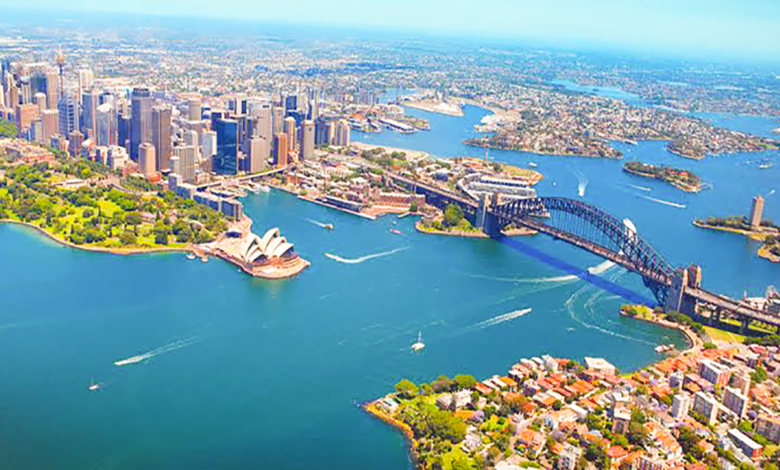
Introduction
Australia, the land down under, is a continent of unparalleled beauty and diversity. From the sunburnt Outback to the vibrant cities and stunning coastlines, Australia offers travelers a unique blend of natural wonders, cultural experiences, and adventures. This essay explores the magic of travel and tourism in Australia, providing a traveler’s guide and insights into fast transport routes between its major cities, all conveyed in a humane and dramatic writing style.
The Essence of Australia
A continent of contrasts.
Australia’s vast landscape is a dramatic stage where nature performs its most spectacular acts.
- The Outback : The heart of Australia is the Outback, a remote and rugged land where the red earth meets the endless sky. Here, travelers can witness the majestic beauty of Uluru (Ayers Rock), a sacred monolith that rises from the desert floor, glowing in the hues of dawn and dusk.
- The Great Barrier Reef : Off the coast of Queensland lies the Great Barrier Reef, the world’s largest coral reef system. This underwater paradise, teeming with vibrant marine life, invites visitors to dive into its crystal-clear waters and explore a world of breathtaking beauty.
Cities of Culture and Innovation
Australia’s cities are dynamic hubs of culture, innovation, and human creativity.
- Sydney : The iconic Sydney Opera House and the towering Harbour Bridge define the skyline of Sydney, a city that blends natural beauty with cosmopolitan flair. Stroll through the historic Rocks District , enjoy the surf at Bondi Beach , or take a ferry to Manly for stunning coastal views.
- Melbourne : Known for its artistic vibe and cultural richness, Melbourne is a city of hidden laneways, world-class galleries, and vibrant street art. The city’s coffee culture is legendary, and its culinary scene is a melting pot of global flavors.
Indigenous Heritage and Modern Australia
Australia’s soul is deeply intertwined with its Indigenous heritage, a rich tapestry of stories, traditions, and connections to the land.
- Aboriginal Culture : Engage with the world’s oldest living cultures through experiences like the Tjapukai Aboriginal Cultural Park in Cairns or the Kakadu National Park in the Northern Territory, where Indigenous guides share their knowledge and traditions.
- Modern Australia : The contemporary Australian spirit is one of inclusivity and innovation. Festivals like Vivid Sydney and Melbourne International Arts Festival showcase the country’s vibrant cultural landscape.
A Traveler’s Guide to Australia
Planning your journey.
Australia’s vastness requires thoughtful planning to make the most of your visit.
- Research and Booking : Use platforms like TripAdvisor , Expedia , and Booking.com to research destinations and book accommodations. Consider the seasonal variations; for instance, the best time to visit the southern cities is during their summer months (December to February), while the northern regions are ideal in the winter (June to August).
- Itinerary : Craft an itinerary that balances urban exploration with nature adventures. Include must-see landmarks, hidden gems, and time for relaxation.
Fast Transport Routes
Navigating Australia efficiently is crucial given its size. Here are some key transport routes between major cities:
- Sydney to Melbourne : The fastest route is by air, with multiple daily flights taking around 1.5 hours. For a scenic journey, consider the XPT train or a road trip along the Hume Highway .
- Melbourne to Brisbane : Direct flights take about 2 hours. Alternatively, embark on a road trip along the Pacific Highway , passing through beautiful coastal towns.
- Sydney to Brisbane : A flight takes approximately 1.5 hours. The Pacific Highway offers a picturesque drive, with stops at places like Byron Bay and the Gold Coast .
- Adelaide to Perth : Flights are the most practical, taking around 3 hours. For the adventurous, the Indian Pacific train offers a transcontinental journey through the heart of Australia.
Embracing the Experience
Travel in Australia is about immersing yourself in the moments and stories that the land and its people offer.
- Cultural Sensitivity : Respect the customs and traditions of Indigenous communities. Engage with local guides and support Indigenous-owned businesses to gain a deeper understanding of their rich heritage.
- Adventure and Relaxation : Balance your adventure with moments of tranquility. Hike through the Blue Mountains , snorkel in the Great Barrier Reef, or simply relax on the beaches of the Whitsunday Islands .
Traveling through Australia is a dramatic and enriching experience, a journey that unfolds like a grand narrative filled with captivating landscapes, vibrant cities, and profound cultural encounters. By planning carefully, navigating efficiently, and embracing the spirit of adventure and respect, travelers can unlock the full magic of this extraordinary continent. Australia, with its bound

the incredible diversity of Australia’s Indigenous cultures and their profound impact on the travel experience.
Australia is home to the world’s oldest continuous living cultures, with Indigenous Australians having inhabited the continent for over 65,000 years. When traveling through Australia, visitors have the opportunity to engage with and learn from these diverse Indigenous communities, each with its own rich history, traditions, and connection to the land.
Exploring Indigenous culture in Australia can involve various experiences, such as attending cultural festivals, participating in traditional ceremonies, visiting art galleries showcasing Indigenous artwork, and joining guided tours led by Indigenous guides. These encounters provide a unique perspective on the country’s history, spirituality, and the enduring connection between the Indigenous people and their ancestral lands.
One particularly remarkable aspect of Indigenous culture is the art. Aboriginal and Torres Strait Islander art is renowned worldwide for its vibrant colors, intricate patterns, and storytelling nature. From ancient rock art sites, such as Kakadu National Park in the Northern Territory, to contemporary art galleries in major cities like Sydney and Melbourne, travelers can immerse themselves in the beauty and significance of Indigenous artistic expressions.
Moreover, engaging with Indigenous communities offers an opportunity to understand their deep spiritual connection to the land known as “Country.” Visitors can learn about the Dreamtime stories, which explain the creation of the land and its features, and gain insights into the sustainable practices that have sustained Indigenous communities for millennia.
While traveling in Australia, meaningful interactions with Indigenous people can foster a profound appreciation for their resilience, cultural knowledge, and the ongoing struggle for recognition and reconciliation. These encounters can be transformative, leaving a lasting impact on travelers by challenging preconceived notions and fostering greater respect and understanding.
but the unique and memorable experience of engaging with Indigenous cultures and exploring their rich heritage adds an extra layer of depth and significance to any journey. By embracing the opportunity to learn from and connect with the world’s oldest living cultures, travelers can forge a deeper connection with Australia’s land and its people, creating memories that will endure long after their visit.

When engaging with Indigenous communities in Australia, it is essential for travelers to approach these interactions with respect, cultural sensitivity, and a willingness to learn. Here are some guidelines to respectfully engage with Indigenous communities and learn about their traditions during your visit:
- Educate Yourself: Before visiting Indigenous communities, take the time to educate yourself about their culture, history, and protocols. Understand that Indigenous cultures are diverse and vary across different regions of Australia. Read books, watch documentaries, and explore reputable online resources to gain a foundational understanding.
- Seek Permission and Follow Protocols: Many Indigenous communities have their own protocols and restrictions regarding access to their lands and cultural sites. Prioritize obtaining permission and following any guidelines or restrictions that may be in place. Seek guidance from local tourism centers or Indigenous organizations to ensure that you are respecting any protocols.
- Participate in Cultural Experiences: Participate in organized cultural experiences or activities offered by Indigenous-owned and operated businesses. These experiences may include guided tours, cultural performances, bushwalks, or workshops. By engaging with these activities, you support the local community while learning about their traditions directly from those who practice them.
- Engage with Respect: Approach interactions with Indigenous individuals and communities with respect and an open mind. Be aware that some topics may be sensitive or sacred, and it’s important to avoid prying or intrusive questions. Listen actively, ask questions respectfully, and be open to learning from their perspectives.
- Support Indigenous Artists and Businesses: Purchase artwork, crafts, and products directly from Indigenous artists and businesses. This supports their livelihoods and helps to preserve and promote Indigenous cultural practices. Ensure that the products you purchase are authentic and ethically sourced.
- Follow Cultural Etiquette: Respect cultural etiquette and follow any guidelines provided by the community. This may include not taking photographs or videos in certain areas, not touching sacred objects or artworks without permission, and refraining from sharing sensitive information or stories without consent.
- Be Mindful of the Environment: Respect the natural environment and sacred sites. Follow any instructions regarding waste disposal and minimize your impact on the land. Avoid littering and damaging any flora or fauna.
- Leave No Trace: When visiting sacred or culturally significant sites, remember to leave no trace behind. Take your rubbish with you, respect the environment, and leave the area as you found it.
- Support Indigenous Causes: Consider supporting Indigenous causes and initiatives beyond your visit. This could involve donating to Indigenous-led organizations, advocating for Indigenous rights, or sharing knowledge and awareness about Indigenous issues.
Remember, engaging respectfully with Indigenous communities is an ongoing commitment to understanding, respect, and reconciliation. By approaching these interactions with humility and a desire to learn, travelers can foster meaningful connections while contributing to the preservation and celebration of Indigenous cultures in Australia.

Supporting Indigenous-owned businesses and artists during your visit to Australia is a meaningful way to contribute to their economic empowerment and cultural preservation. Here are some ways you can best support Indigenous-owned businesses and artists:
- Research and Plan Ahead: Prior to your trip, research Indigenous-owned businesses and artists in the regions you plan to visit. Look for galleries, shops, markets, or online platforms that showcase and sell Indigenous artwork, crafts, clothing, or other products. This will help you identify opportunities to support them during your visit.
- Purchase Directly from Indigenous Artists and Businesses: Whenever possible, purchase directly from Indigenous artists and businesses. Seek out galleries, art centers, cultural centers, or markets that are owned and operated by Indigenous individuals or communities. By buying from them, you ensure that a fair portion of the proceeds goes directly to the artists and entrepreneurs.
- Buy Authentic Indigenous Art: Indigenous artwork holds deep cultural and spiritual significance. When purchasing Indigenous art, ensure that it is authentic and ethically sourced. Look for art that comes with a certificate of authenticity or is sold through reputable galleries or Indigenous-owned businesses. Authentic Indigenous art supports the artists and helps to preserve their cultural heritage.
- Attend Indigenous Art and Cultural Events: Explore Indigenous art exhibitions, cultural festivals, and events that showcase the work of Indigenous artists and performers. These events often provide opportunities to meet and engage with artists directly, learn about their creative processes, and purchase their work.
- Respect Intellectual Property Rights: Indigenous art and cultural knowledge are protected by intellectual property rights. Respect these rights by not reproducing or copying Indigenous artwork or cultural expressions without permission. Ensure that the artwork or products you purchase are sourced from legitimate and authorized channels.
- Spread the Word: Share your positive experiences and discoveries with Indigenous-owned businesses and artists with others. Word-of-mouth recommendations, social media posts, and online reviews can help raise awareness and support for their work. Tag and promote their social media accounts, websites, or online platforms to increase their visibility.
- Engage in Cultural Experiences: Participate in cultural experiences and activities offered by Indigenous-owned businesses. This may include guided tours, workshops, performances, or culinary experiences. Not only will you support the local community, but you will also gain a deeper understanding of Indigenous culture and traditions.
- Educate Yourself and Others: Take the time to learn about the significance and history behind Indigenous artwork and cultural practices. Educate yourself about the diversity of Indigenous cultures in Australia and the challenges they face. Share this knowledge with others to promote understanding and appreciation.
Remember that supporting Indigenous-owned businesses and artists is an ongoing commitment. Even after your visit, you can continue to support them by purchasing their products online, connecting with them through social media, or recommending them to fellow travelers. By actively supporting Indigenous entrepreneurs and artists, you contribute to their economic empowerment, cultural preservation, and the recognition of their valuable contributions to Australian society.
admin-travellsmartly
With product you purchase, subscribe to our mailing list to get the new updates.
Lorem ipsum dolor sit amet, consectetur.
Exploring the United States: An Essay on Tourism and Travel
Exploring fiji: an essay on travel and tourism, related articles.
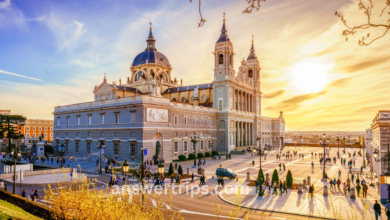
The best tours and a traveler’s guide in Spain with the family
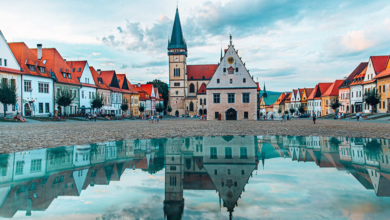
Explore Slovakia: the best family tours

Explore Serbia: the best comprehensive guide for unforgettable family travel
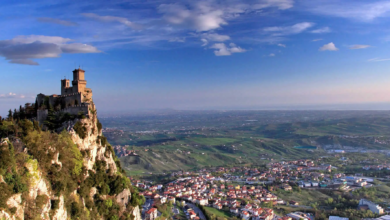
Discovering San Marino: the best sightseeing tours with the family
Leave a reply cancel reply.
Your email address will not be published. Required fields are marked *
Save my name, email, and website in this browser for the next time I comment.
How to plan a camper trip around Australia

Sep 11, 2024 • 8 min read

Plan your motor home travels around Australia with this guide to routes, seasons and vehicles. Benjamin Probert/Getty Images
There’s no better way to experience the best of Australia than on a road trip in a camper through its stunning and wild natural landscapes.
Australia’s National Highway 1 may not be as storied as America’s Route 66, but a “lap of the map” – via endless surf beaches, koala-dotted forests, flaming red deserts and awe-inspiring starry skies – will be life-defining. If you haven’t got time for the whole shebang, you’ll have just as much fun exploring one coast (the east coast or west?) or even a smaller region.
While there’s buckets of information out there from travelers who’ve gone before, here are the key things to consider before you hit the road for your motor home adventure in Australia.

On a short break, focus on one region
If you have only a few weeks then you’ll need to stick to one region. If you want to spend more time communing with nature and less time driving then you might want to target a small region.
For a mix of beaches , mountains and waterfalls head to northern NSW ( Byron Bay and around) and southern Queensland (with an incredible coast and the lush Scenic Rim region). For something similar but with emptier roads, check out the coast southwest of Perth around Margaret River and inland to the old forests of Pemberton. Tasmania is also very driveable in two weeks with mountains, beaches and delicious produce everywhere.
Flying into Darwin would take you to some of the most incredible scenery in Australia around Litchfield , Kakadu and down to Uluru and back. From Adelaide , there are options to explore the coast, wineries and wetlands south, or head into the ancient interior of Ikara-Flinders Ranges via the wineries of the Clare Valley.
The coastal roads from Melbourne to Sydney through southern NSW are long and windy, and the geography doesn’t vary quite as much, but the weather is temperate and there are many family-friendly hamlets with good camping sites. Picking up a camper in Cairns means exploring the lush Atherton Tablelands, and the UNESCO World Heritage-listed Daintree National Park , managed by its traditional owners the Eastern Kuku Yalanji people (learn more on a Dreamtime Walk at Mossman Gorge ) and the Great Barrier Reef .
But this is just a snapshot of options . With more time you can join a couple of these itineraries together and cruise on – say from Adelaide to Darwin, or from Sydney up to Cairns via Byron Bay in one trip.
Allow at least three months for a "lap of the map"
Some travelers make it their mission to circumnavigate the whole of Australia, and you’ll find plenty of blogs online with people sharing their tips for tackling the project over anything from six weeks to a year.
Three months is a good minimum to dedicate to the trip. It gives you enough time for detours and longer stops at places you fall in love with, but you can also manage costs (the longer you’re away the more you spend, and there's greater chance that mechanical wear and tear will blow out your budget).
May to October is the best time for a camper trip in Australia
Assuming you have only 12 weeks, the best time to go will be during Australia’s cooler months (May to October). In the north, you’ll be traveling in the dry season (any other time of year and a lot of the roads are impassable). Down south, it’ll be cool (cold even, with potential for snow on the Great Dividing Range) in southern NSW and Victoria – but this means campsites and caravan parks won’t be as busy.
December and January are best avoided. These months are school holidays, which means contending with domestic travelers on big summer camping trips. It's also a time with sweltering days where your legs stick to the car seat and the steering wheel is too hot to touch (although this could happen anytime from November to March).
If you’re traveling on a working holiday visa you’ll be able to stop and take up job opportunities wherever they find you – or if you’re on a self-funded gap year and can spend even longer traveling around Australia in your campervan – then you will be traveling in all seasons. Just make sure that you're not attempting to visit the north outside the dry season.

Buying a camper can be cost-effective
Some travelers choose to pull some savings together to buy a vehicle for their once-in-a-lifetime campervan trip in Australia. This can prove cost-effective if you get the right vehicle and look after it, making it possible to sell it at the end of your adventure (with some anticipated depreciation for the extra mileage). As well as the cost of the actual van, you’ll need to factor in other expenses like registration (“rego”); insurance; a roadworthiness certificate (RWC); repairs needed to get one to resell later; and equipping the vehicle with any extras you might want such as a campfire oven, outdoors shower, bikes or canoes.
Rental firms offer a large range of motor homes and vans
Another option is to rent a vehicle from a reputable hire company. In addition to international chains like Avis, there are Australia/NZ-specific ones to check out like Apollo, Maui and Britz.
You’ll have a large range of vehicles to choose from whether you’re looking for a top-of-the-line motor home/RV or very minimal van set-up or roof-top tent. Age and mileage are things to take into account when choosing between companies. The less expensive brands – usually marketed to backpackers – have older vehicles. Vans with Cheapa Campa , for example, are four years on fleet and older.
You’ll need everyone who’s planning to drive to be at the vehicle collection with their driver’s license, plus a credit card (not a debit card) and an upfront security deposit to cover any potential damage. The best advantage of using a rental company is being able to choose a one-way trip: you could drive from Melbourne to Cairns or Perth to Broome (should you decide to tackle one coast or the other) without having to backtrack.
Peer-to-peer campervan rentals are usually well equipped
Just as there is AirBnB for homestays, the Australian company Camplify (now also in the UK and Spain) enables campervan owners to rent to travelers directly. The costs are more affordable, and are usually well set up for an off-grid camping adventure. Some come with solar panels and decent batteries to run devices like fridges and even satellite broadband, so you won’t find yourself without any internet signal in the middle of nowhere.
When booking you get the option of adding extra insurance to reduce the “excess” you pay out of pocket should you have an accident. The only downsides: you have to return the camper from where you borrowed it, and owners can refuse your request based on your age or planned itinerary leaving the door open for discriminatory decisions. Fortunately there are loads of campers available, so you can take your pick.

Be realistic about how much space and comfort you need
Discuss what style of camper you want (and can afford) with your travel crew. Don’t forget to consider things like how you’ll manage if you don’t have showers, a camp kitchen, or toilets on board: you’ll need to budget to stay in places with facilities and (if you’re in for the long-haul time) to stop to do laundry occasionally. You also need to plan for disposing of your waste and storing things carefully overnight to ensure your campsite is not raided by local wildlife.
Living in a small space can be challenging, (especially if one of your party is not very good at putting things away), while long drives, heat, and discomfort, can all take their toll. Consider honestly whether an RV vacation is the right trip for you before you invest in buying or hiring a motor home for a long trip. You are not going to be napping with a view of the ocean every day and some days you’ll be on the road for long stretches – Australia is big.
Get breakdown cover and download useful apps before departure
As well as adequate travel insurance to cover your vehicle and any extras, it’s a good idea to join a road users' association like the RACV or NMRA for roadside assistance in case of a breakdown.
There are also some excellent apps to help you on the road. Download them and make the most of them when you’ve got data (there are plenty of places in Australia without mobile signal).
- Wikicamps is good for free or low-cost campsites
- CamperMate includes free and paid campsites as well as facilities you will need
- Hipcamp directs you to secluded spots on private property where you can pay to camp for the night.
- Fuel Map Australia directs you to the nearest petrol stop (although current fuel prices are not reliable)
- The Bureau of Meteorology (BOM) app is a must-have for local forecasts – and potential weather warnings.
Whether you’re going solo, with friends, or taking your family on a special bucket-list trip, it’s time to get planning .
Explore related stories

Aug 23, 2024 • 7 min read
There’s nothing like hitting the road in an RV or camper van – these are the best destinations around the world for an RV road trip.

Sep 11, 2024 • 5 min read

Sep 11, 2024 • 6 min read

Sep 11, 2024 • 11 min read

Sep 11, 2024 • 15 min read

Sep 11, 2024 • 10 min read

Sep 11, 2024 • 7 min read

Equipment, design upgrades and new terminal revealed in plans for $5 billion airport project in Brisbane
By Julius Dennis
Topic: Air Transport Industry
Brisbane Airport is being renovated as part of a $5 billion plan to give the international terminal a makeover, upgrade the domestic terminal, and work to construct a third terminal.
The upgrades focus on security and passenger experience, while the new terminal will service both domestic and international travellers.
What's next?
There may be some impact to passengers flying to and from Brisbane, with work on the international terminal expected to wrap up in 2027.
Brisbane's international airport is getting a facelift as part of a $5 billion plan to upgrade the airport over the next decade.
The plan also includes the construction of a third terminal and upgrades to the domestic terminal.
"We have begun planning for a terminal three development, which will be conveniently located between our two parallel runways," Brisbane Airport Corporation (BAC) chief executive Gert-Jan de Graaff said on Thursday.
Gert-Jan de Graaff said the new terminal will service both domestic and international travellers. ( ABC News )
It's planned that the third terminal will service both domestic and international flights.
Mr de Graaf said the upgrades at the airport are focused on security and passenger experience, but notes that the airport is "currently not capacity".
The new design features space for multiple dining options within the terminal. ( Supplied )
"There is still room in the existing building for more flights," he said.
BAC said it needed to upgrade its security measures by end of 2025 to meet government standards.
The makeover is part of a multi-billion-dollar plan to upgrade Brisbane's airport. ( Supplied )
Jeff Moomaw from Delta said the US airline would start flying into Brisbane from December 4.
He said the airport upgrades would bring Queensland in line with other major international terminals, such as Los Angeles.
Mr Moomaw said Brisbane's growing population, commercial opportunities, and strong tourism market have played a part in the airline's decision to fly in and out of Brisbane.
What's changing at the airport?
The revamp of the international terminal will streamline and upgrade security measures and implement self-service check-in and more efficient baggage systems.
It is hoped new computed tomography bag screeners, which allow passengers to leave laptops and tablets in their bags, will make for faster-moving queues.
The same technology will be used in the domestic terminal.
The new technology is expected to make the check-in process quicker. ( Supplied )
BAC said ground support equipment such as "pushback tugs, belt loaders, cargo loaders, and baggage tugs" will be converted from fossil fuels to electric as part of the project.
It is expected construction at the international terminal will be finished in 2027.
Mr de Graaf said while guarantees are "very difficult to give" he remains confident the expansion project will be finished in time for the 2032 Olympic and Paralympic Games.
Mr de Graaf acknowledged that the work about to get underway would have "some impact on passengers".
"We will do everything possible to minimise that. That's why this is quite a lengthy project, because we do everything in incremental steps," he said.
But he said they do not expect the work to increase the time people spend at the airport and that people would not need to arrive any earlier than normal for flights.
Australian commanders stripped of Afghan war honours after war crimes investigation
The defence minister's call is the final step in implementing recommendations of the brereton report into "arguably the most serious allegations of australian war crimes in our history"..
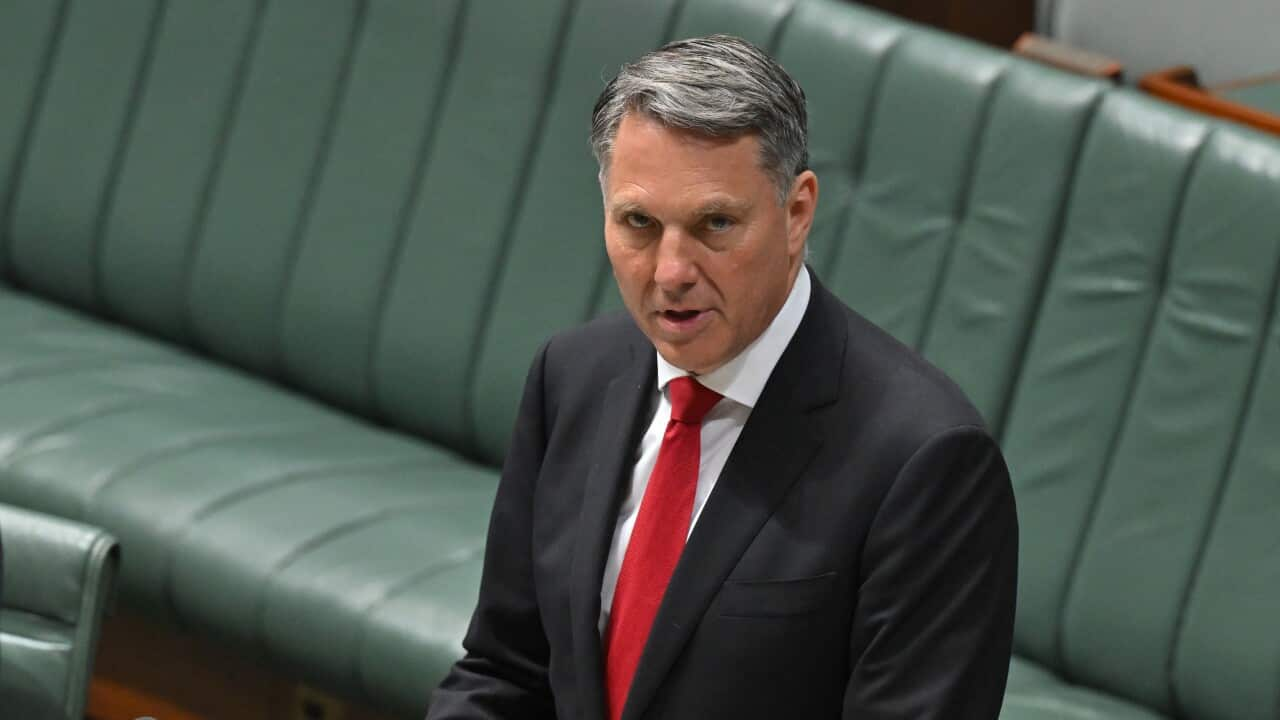
Defence Minister Richard Marles has announced Australian Defence Force commanding officers have been stripped of their war honours. Source: AAP / Mick Tsikas
- High ranking Australian soldiers have been stripped of their war medals.
- Defence Minister Richard Marles has sent letters to the relevant senior soldiers of his decision.
- Defence has implemented all recommendations from the Brereton inquiry into alleged war crimes during the Afghan war.

The main takeaways from the Afghan war crimes report and what will happen next
Command group was 'accountable' over war crimes

Australia warned Afghan war crimes allegations could hurt US cooperation
Afghanistan inquiry now ‘closed’
Share this with family and friends
Recommended for you

Andrew suppressed the pain of racism for decades. Why can't we talk about the 'R' word?
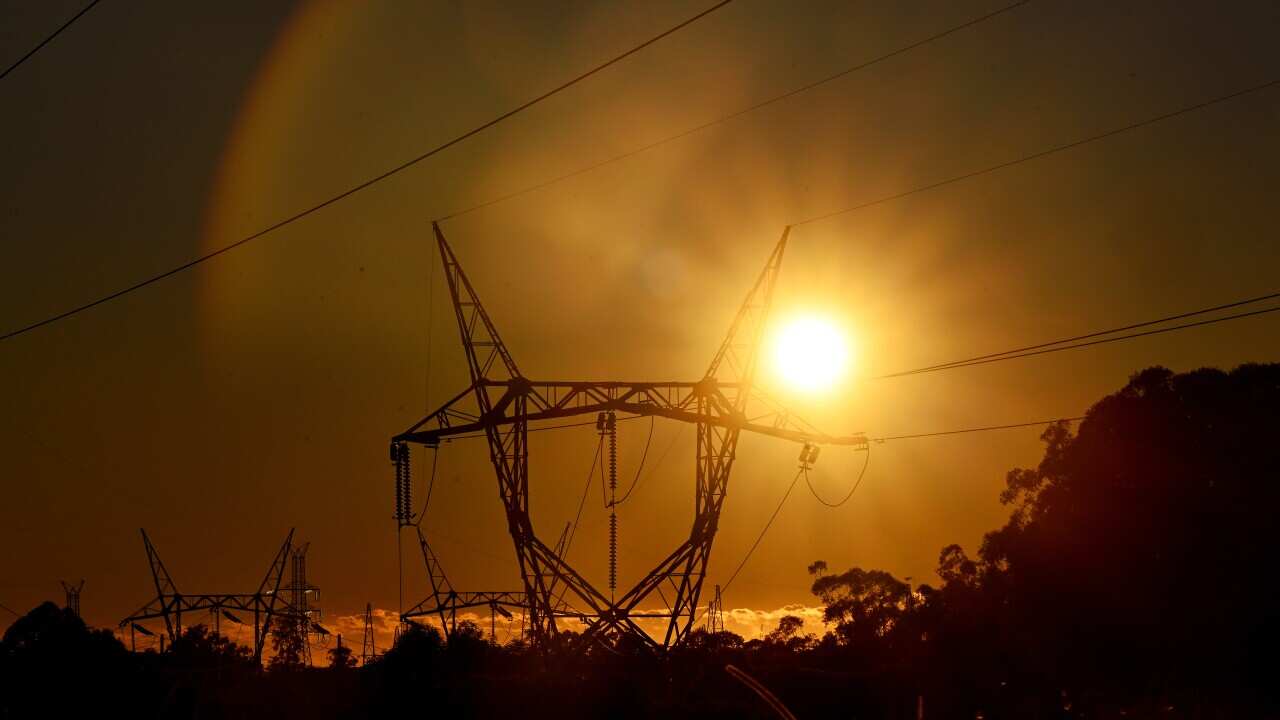
The two places 'undermining' Australia's efforts to cut emissions
Renewable energy

Australians could get two new COVID-19 vaccines — but they have something missing
Immunisation

'I migrated the proper way': Advocates appalled by Labor MP's message to asylum seekers
Immigration policy

Sticky beaks: Birds of prey defy strata company to raise family
Environment and nature

'You'd need to be a millionaire': The 'permanent cruisers' who docked in a remote Aussie town
Travel and tourism

New twist as Singapore weighs in on Perth's huge 'boom' mystery

The new amount Australians need each year to retire comfortably
Superannuation
Get SBS News daily and direct to your Inbox
Sign up now for the latest news from australia and around the world direct to your inbox..
Morning (Mon–Fri)
Afternoon (Mon–Fri)
By subscribing, you agree to SBS’s terms of service and privacy policy including receiving email updates from SBS.
SBS World News

IMAGES
VIDEO
COMMENTS
Essay About Australia Travel. 1940 Words8 Pages. Australia is one of the most popular travel destinations in the world. It's known as a major backpacking, camping, and driving destination, but no matter what your travel style is, there is something to draw you here. The country is filled with incredible natural beauty from Uluru to the ...
With its wide range of attractions, Australia provides a remarkable travel experience. Whether you love nature, history, or city life, Australia has something for everyone. 250 Words Essay on Australia Tourism Introduction. Australia, a vibrant land of breathtaking landscapes and cosmopolitan cities, is a prime destination for global tourists.
Don't just take our word for it - researchers regularly rank Australia as one of the world's best places to live and visit (read: laid-back, relaxed, fun). The 2,800 annual hours of sunshine, magnificent native scenery and delicious local gastronomy all contribute to making Australia a land like no other.
M y answer has always been short and simple: Because I love Australia. Australia is an excellent country for women travelling alone over 50. On my solo travels in Australia, I discovered beautiful places that had sometimes been hard to leave. Here are the places I love in Australia and why I fell in love with the country.
3. Sydney, New South Wales. Australia's best city for outdoor activities. Sydney is rightfully considered one of the world's most beautiful cities, where the natural splendor of cityside beaches collides with incredible urban architecture, including the Opera House.
Like many of the hyper-cool neighborhoods in the world's great cities, Chippendale was once a slum that has transformed over time into a mecca of art, design, and food. I was there during Vivid ...
250 Words Essay on Australia Introduction. Australia, often referred to as "Down Under", is a unique country that is also a continent. It is renowned for its rich culture, diverse ecosystem, and vibrant economy. Geography and Biodiversity. Australia is the world's smallest continent but the sixth-largest country by land area.
Bring your travel dreams to life and plan the best places to visit with this list of the top attractions in Australia. On This Page: Sydney Opera House, New South Wales. Great Barrier Reef Marine Park, Queensland. Uluru-Kata Tjuta National Park, Northern Territory.
2. Perfect for Road Trips. Not only is Australia the 6th largest country in the world (and an entire continent by itself), but it is criss-crossed by 542,813 miles of roads - that's a lot of potential driving!. Australia is THE place to go off the beaten path! You can go camping and enjoy the solitude, or explore many of the lesser-known towns and villages you come across.
Creating an outline is the first step to writing a perfect traveling essay. This will help you stay on track and avoid missing any vital information. The outline should include a thesis in the introduction, key points, and concluding thought. The thesis should sum up the central point of the traveling essay.
14. Walk on the left. On sidewalks, trails and stairs, sticking to the left helps maintain a smooth flow of foot traffic and prevents any awkward dance moves with strangers trying to pass. Some train stations have arrows to direct the flow. This practice also aligns with Australia's left-hand driving tradition.
Introduction. Australia is a major tourist attraction for people travelling from South-East Asia and from Europe, with numerous airlines serving various sectors of passenger's journeys. Many flights from the Asian region are connecting flights for tourists and serve as stopover countries. Major airports in this region include Singapore Changi ...
Decent Essays. 793 Words. 4 Pages. Open Document. Australia is a country where one would love to explore or spend a holiday. Travelling to Australia can be very expensive so you need to set a budget before stepping on to this foreign land. To have a satisfying, enjoyable and heart wrecking holiday, here are a few thing you need to consider ...
Planning your ultimate trip to Australia? Here is everything you need to know before you go, from entry requirements to must-visit destinations and itineraries. ... COVID-19 travel and entry advice. Customs and biosecurity. Working Holiday Maker visas. View more. Facts about Australia. Experiences that will make you feel like an Aussie.
Australia has an exciting calendar of events and festivals, where locals and visitors alike gather to celebrate food, sport, art and culture. Australia hosts world-renowned sporting events like the Australian Open tennis tournament and the Sydney to Hobart yacht race. Of course, Australia's sense of humour has hatched more than a few quirky ...
Travel Writing Australia. AS and A Level English. Michael Finch RPF. Travel Writing Coursework. Down Under. It's the driest, hottest, most infertile and climately aggressive of all the inhabited continents, home to the most dangerous animals on the planet. Australia is a country tanned red by the scorching sun that beams down endlessly ...
Personal Narrative Essay: My Trip To Australia. My Trip to Australia When you go to Australia you see amazing attractions that you'll never see anywhere else. I know this because I was born in Australia and I have been there many times. In my most recent trip to Australia I went to the Opera House, Taronga Zoo, and Seaworld.
"Australian Travel Writing, 1900-1960" published on by Oxford University Press. Travel writing has been an important form through which Australians learned about their own culture and their place in the world. Indigenous cultures of place and travel, geographic distance from the imperial metropole, and a long history of immigration have each ...
Here are some interesting Australia Facts which were chosen and researched by kids especially for kids. Name: Commonwealth of Australia. Government: Democracy. Population: About 26.4 million (2023) Urban Population: 90%. Capital: Canberra with 472,000 people. Language: English. Unemployment: 12%.
To protect the anonymity of contributors, we've removed their names and personal information from the essays. When citing an essay from our library, you can use "Kibin" as the author. Kibin does not guarantee the accuracy, timeliness, or completeness of the essays in the library; essay content should not be construed as advice.
9Travel and Today 's Aussie Travel Trends Index surveyed Nine audiences across TV, digital, print and radio, to find out your favourite travel destinations. Here are the results. From sand and tropical rainforests to deserts and wide-open plains, Australia is home to some of the most stunning holiday destinations in the world.
The scholars will also find images of the giant windmills that began to cover the landscape as power stations closed and the country's leaders held hands and cried "net zero, net zero" and as they did, the lights went out for the last time and darkness enveloped the land and the great country that was once Australia was no more.
Accessible ways to experience Australia's icons. Hobart / nipaluna. The best places to see wild koalas. Mornington Peninsula. Australia's seasonal nature experiences. Private island vacations in Australia. Canberra. Australia's best natural waterholes. The best places to go foraging in Australia.
Australia, the land down under, is a continent of unparalleled beauty and diversity. From the sunburnt Outback to the vibrant cities and stunning coastlines, ... Destinations Travel Guides Uncategorized Discovering Australia: An Essay on Travel and Tourism. admin-travellsmartly Send an email 2 weeks ago. 0 0 8 minutes read.
There's no better way to experience the best of Australia than on a road trip in a camper through its stunning and wild natural landscapes.. Australia's National Highway 1 may not be as storied as America's Route 66, but a "lap of the map" - via endless surf beaches, koala-dotted forests, flaming red deserts and awe-inspiring starry skies - will be life-defining.
In short: Brisbane Airport is being renovated as part of a $5 billion plan to give the international terminal a makeover, upgrade the domestic terminal, and work to construct a third terminal.
Virgin Australia's plan to be the first airline in the nation to allow pets on planes has prompted fierce debate among travellers. While some pet owners look forward to travelling with their cat ...
Air travel in Australia is entering a 'new normal'. Here's what that means for flight prices. Travel and tourism. Why Australians are buying EVs even if they can't charge the cars at home.